
Creating an effective employee nomination form is essential for building a recognition-rich workplace culture that celebrates outstanding contributions and drives employee engagement. Organizations across industries struggle to develop nomination form processes that capture meaningful achievements while remaining accessible and fair for all participants. Without structured employee nomination forms, recognition programs often fail to identify deserving employees or create transparent pathways for peer and manager nominations that support award decisions.
The challenge extends beyond simply creating a basic form as successful nomination systems require thoughtful design, clear criteria, and seamless integration with existing workflows. Companies need comprehensive employee nomination form templates that accommodate different award categories, departments, and recognition objectives while ensuring the process remains engaging rather than burdensome for staff and management teams. By implementing well-designed nomination forms, organizations can transform their recognition programs into powerful tools that boost morale, improve retention, and create lasting positive change across teams and communities.
What is an employee nomination and why do they matter?
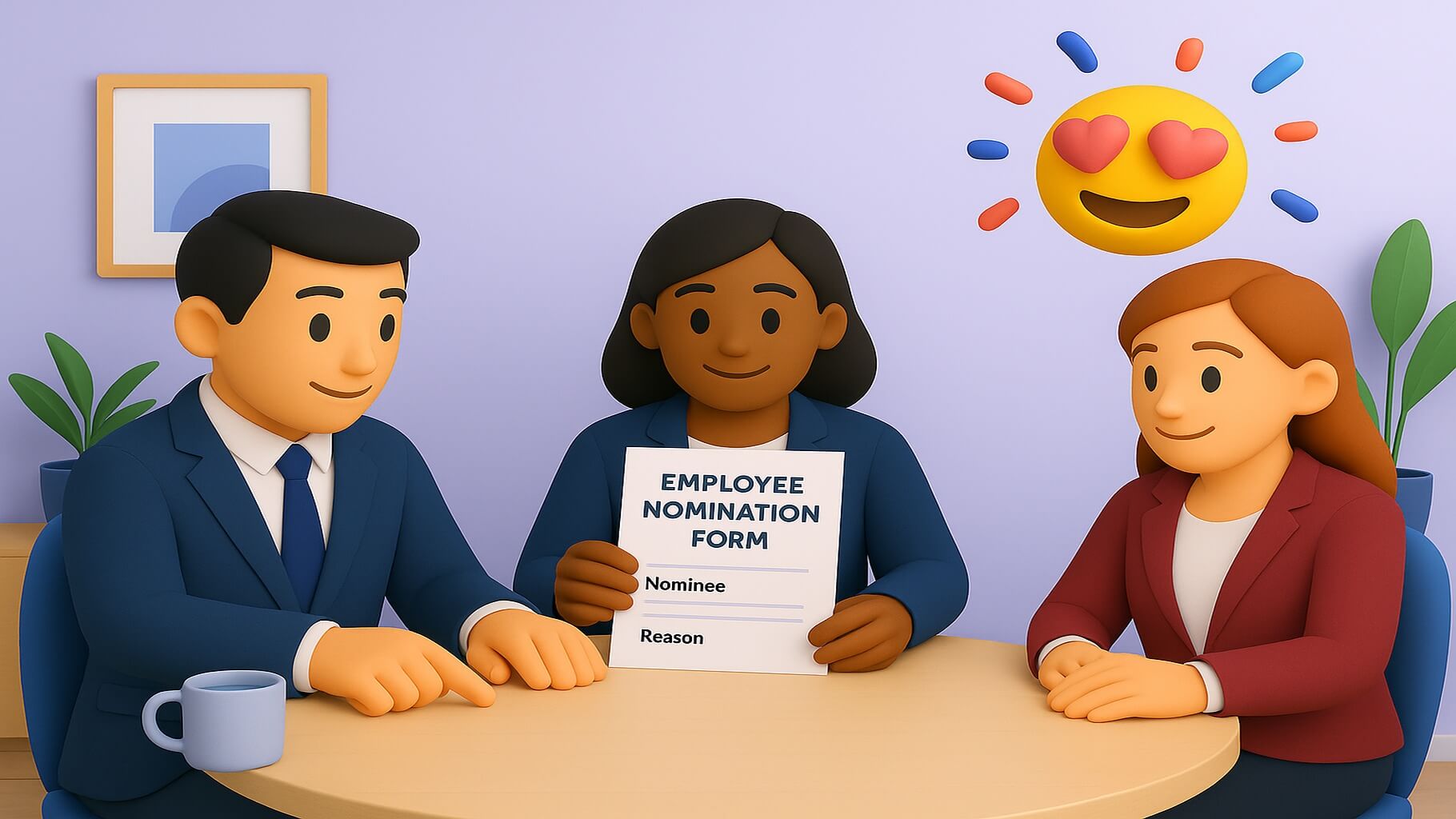
Employee nominations represent a structured approach to identifying and recognizing outstanding workplace contributions through formal submission processes. These employee nomination systems empower team members, managers, and leadership to highlight achievements that align with organizational values and performance standards. The nomination form process typically involves completing a detailed form that captures specific information about the nominee's accomplishments, impact, and qualifications for award consideration.
Modern nomination systems serve as the foundation for effective recognition programs, ensuring that exceptional efforts don't go unnoticed across department boundaries and teams. When employees understand they can nominate colleagues for meaningful recognition through accessible digital tools and structured processes, it creates a culture where everyone feels empowered to celebrate achievements and strengthen workplace relationships through dedicated voting and review mechanisms. Organizations that implement comprehensive employee nomination examples often see increased participation and more meaningful recognition outcomes.
Definition and core purpose of employee nominations
Employee nominations function as formal requests to recognize individuals or teams for exceptional performance, innovative contributions, or embodiment of company values through structured submissions. The core purpose extends beyond simple acknowledgment as these processes create systematic ways to identify talent, celebrate achievements, and reinforce desired behaviors throughout the organization. A well-structured employee nomination form captures essential information including specific accomplishments, measurable outcomes, and the nominee's impact on team or organizational goals through detailed content sections.
The nomination process serves multiple stakeholders by providing employees with clear pathways to recognition while giving leadership valuable insights into team dynamics and individual contributions. When organizations implement comprehensive nomination forms that integrate with existing tools and surveys, they create transparent systems where recognition decisions become more objective and inclusive across all departments and levels, ensuring fairness in award selection processes.
Key components that make employee recognition nomination forms effective
Effective employee recognition nomination forms include several critical elements that ensure comprehensive evaluation and fair consideration of all submissions. The form should clearly describe the award categories, nomination criteria, and submission requirements to help nominators provide relevant information efficiently. Essential components include nominee identification fields, detailed description sections for accomplishments, and space for supporting evidence or examples that demonstrate measurable impact on productivity and team success.
Additional elements that strengthen nomination forms include:
- Clear instructions that guide nominators through the submission process efficiently while maintaining accessibility for all users
- Standardized questions that ensure consistent information collection across all submissions and departments
- Integration capabilities that connect with existing HR systems and review processes to streamline decision making
- Customizable sections that accommodate different award types and organizational needs while supporting diverse communities
How nomination forms differ from other workplace feedback mechanisms
Employee nomination forms serve a distinct purpose compared to performance reviews, surveys, or general feedback tools by focusing specifically on recognition and celebration rather than evaluation or improvement initiatives. While performance reviews assess overall job duties and areas for development, nomination forms highlight exceptional contributions that deserve special acknowledgment through award programs. The voting process for nominations often involves peer input and leadership review, creating collaborative decision making that differs from traditional top-down evaluation methods delivered through standard tools.
Unlike anonymous surveys that gather broad feedback about workplace trends, nomination forms create public recognition opportunities where employees' efforts become visible to colleagues and leadership teams. This transparency builds trust and demonstrates organizational commitment to celebrating success, making the nomination process a powerful tool for enhancing workplace culture and employee engagement across all departments and communities throughout each month.
Why are employee nomination forms important for organizational success
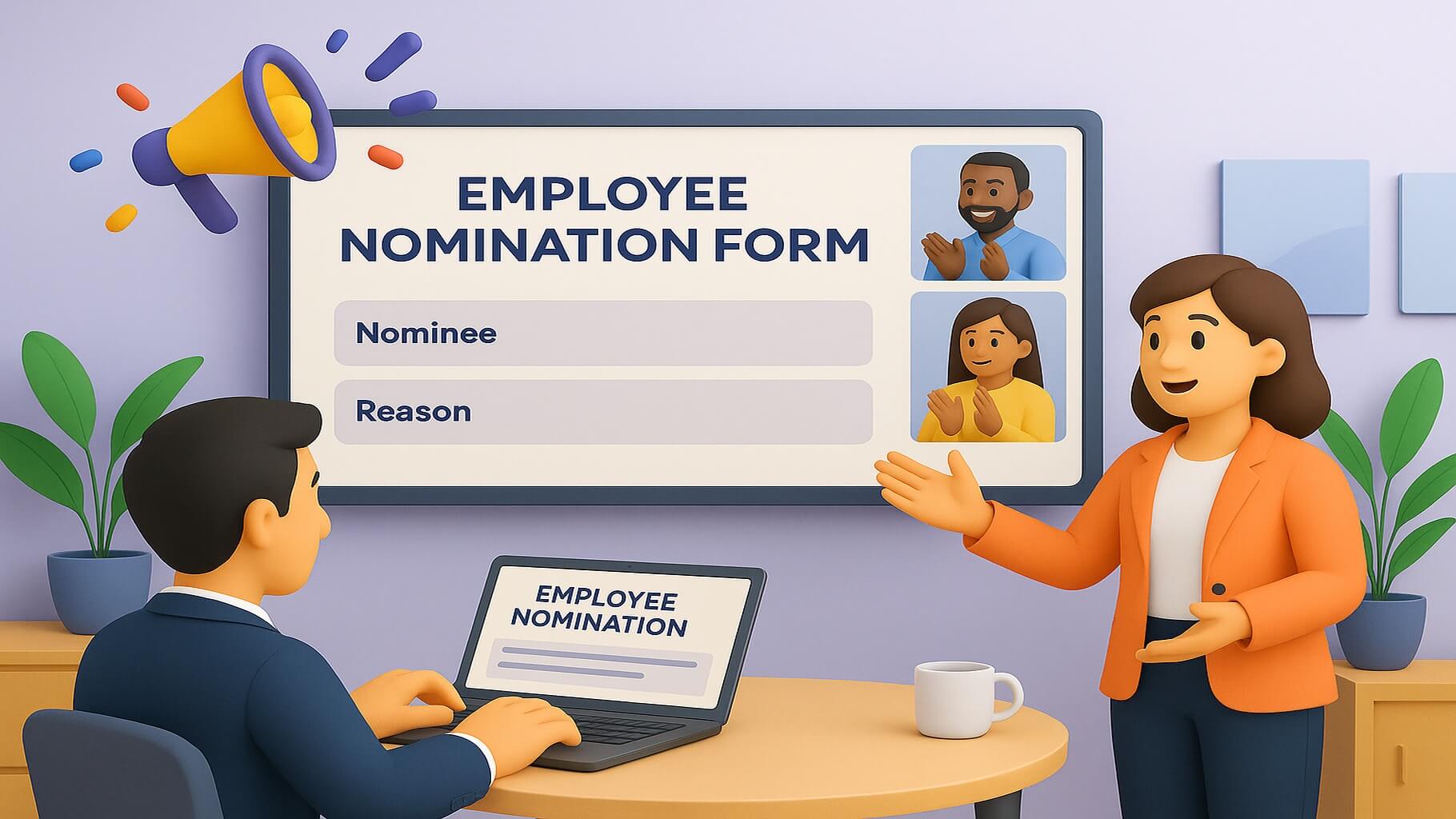
Employee nomination forms create structured pathways for recognition that directly impact workplace culture, employee engagement, and organizational performance across departments and teams. These tools ensure that outstanding contributions receive appropriate acknowledgment while establishing fair and transparent processes for employee rewards and recognition. When organizations implement comprehensive nomination systems that integrate with digital tools and surveys, they provide employees with clear mechanisms to celebrate colleagues' achievements and strengthen team relationships through dedicated voting procedures.
The strategic importance of nomination forms extends beyond individual recognition as these systems generate valuable data about team performance, employee engagement trends, and the effectiveness of current recognition programs. Organizations that utilize well-designed employee nomination forms often see improvements in retention, productivity, and overall workplace satisfaction as employees feel more valued and connected to their teams through structured award processes that meet organizational goals. Understanding employee of the month nomination best practices helps organizations maximize the impact of their recognition efforts.
Impact of structured nomination forms on recognition program participation
Structured employee nomination forms significantly increase participation rates in recognition programs by removing barriers and providing clear guidance for submissions across departments and communities. When employees understand exactly how to nominate colleagues through accessible forms delivered via digital tools, nomination volume typically increases by 40-60% compared to informal recognition systems. The standardized format ensures that all nominators provide relevant information efficiently, making the review process more manageable for decision makers and creating more meaningful recognition experiences for staff.
Research shows that organizations with structured nomination processes see higher employee engagement scores and stronger peer relationships throughout each month. The form-based approach encourages employees to reflect thoughtfully on colleagues' contributions, leading to more detailed and impactful nominations that capture specific efforts and achievements. Additionally, the systematic nature of forms allows organizations to track recognition trends through surveys and analytics, identify high-performing teams, and ensure equitable distribution of awards across departments and roles.
Building fair and transparent recognition through standardized employee nomination forms
Standardized employee nomination forms eliminate bias and subjectivity from recognition processes by establishing consistent evaluation criteria for all submissions across departments and teams. When every nominee receives evaluation through the same employee recognition nomination form structure, organizations ensure fair consideration regardless of the nominator's writing skills or familiarity with the process. This standardization creates trust in the recognition system as employees understand that award decisions follow objective procedures rather than personal preferences, supporting fairness in voting and selection practices.
Organizations that implement sample nomination letter for employee of the month guidelines alongside standardized forms see improved submission quality and more consistent recognition outcomes. Key benefits of standardized forms include:
- Consistent information collection that enables fair comparison between nominations while maintaining accessibility for all users
- Clear criteria that help nominators understand what constitutes award-worthy performance and efforts worthy of recognition
- Reduced administrative burden for reviewers who can efficiently process standardized submissions using dedicated tools
- Enhanced transparency that builds employee confidence in recognition program integrity and decision making processes
Long-term benefits of implementing comprehensive nomination form systems
Organizations that invest in comprehensive employee nomination form systems experience sustained improvements in workplace culture, employee retention, and overall performance across departments and communities. These systems create lasting change by embedding recognition into organizational processes and encouraging regular celebration of achievements through structured award programs. Over time, the consistent use of nomination forms develops recognition habits among employees, leading to more frequent acknowledgment of contributions and stronger team bonds that enhance productivity each month.
The data collected through nomination forms provides valuable insights for organizational development, helping leadership understand which behaviors and achievements deserve recognition through detailed surveys and analytics. This information guides training programs, performance standards, and cultural initiatives that align with demonstrated excellence and support business goals. Additionally, comprehensive nomination systems create historical records of employee achievements that support career development, succession planning, and retention efforts across the organization, while providing valuable content for understanding workforce trends and patterns.
20 best employee nomination form templates and designs
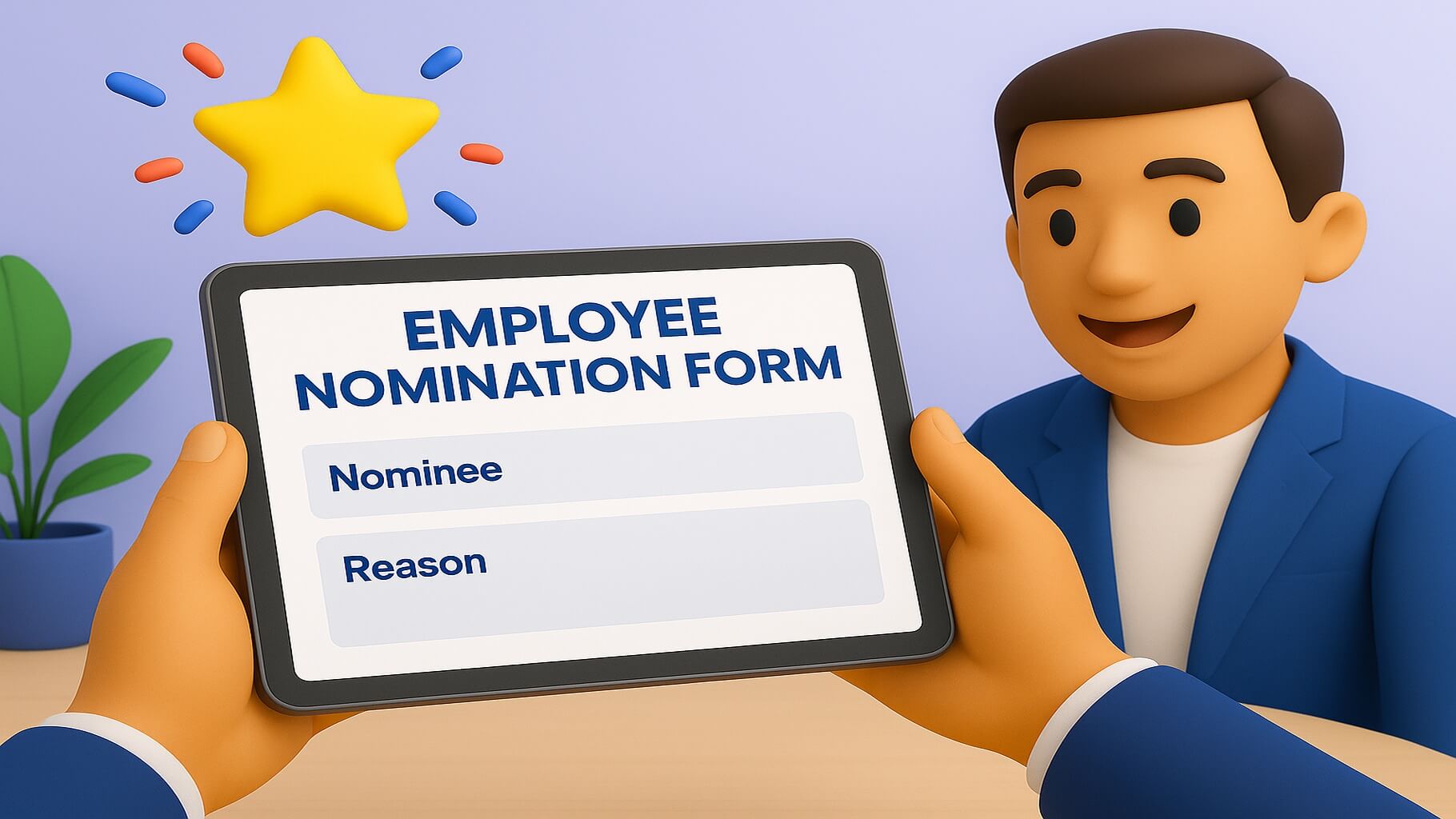
Effective employee nomination form templates provide organizations with ready-to-use frameworks that streamline the recognition process while ensuring comprehensive information collection across departments and teams. These templates accommodate various award types, organizational structures, and submission preferences to meet diverse workplace needs efficiently. The best designs balance thoroughness with user-friendliness, enabling nominators to provide detailed information without creating administrative burdens that discourage participation in voting and review processes.
Modern nomination form templates incorporate both digital tools and printable formats to accommodate different technological preferences and workplace environments. Organizations can customize these templates to reflect their unique values, award categories, and evaluation criteria while maintaining the structural elements that make nomination processes effective and fair for all participants across communities and staff groups each month. Many organizations find success by starting with proven employee of the month nomination template designs and adapting them to meet specific organizational needs.
7 comprehensive employee of the month nomination form template options
Template 1: Achievement-Focused Employee Nomination Form
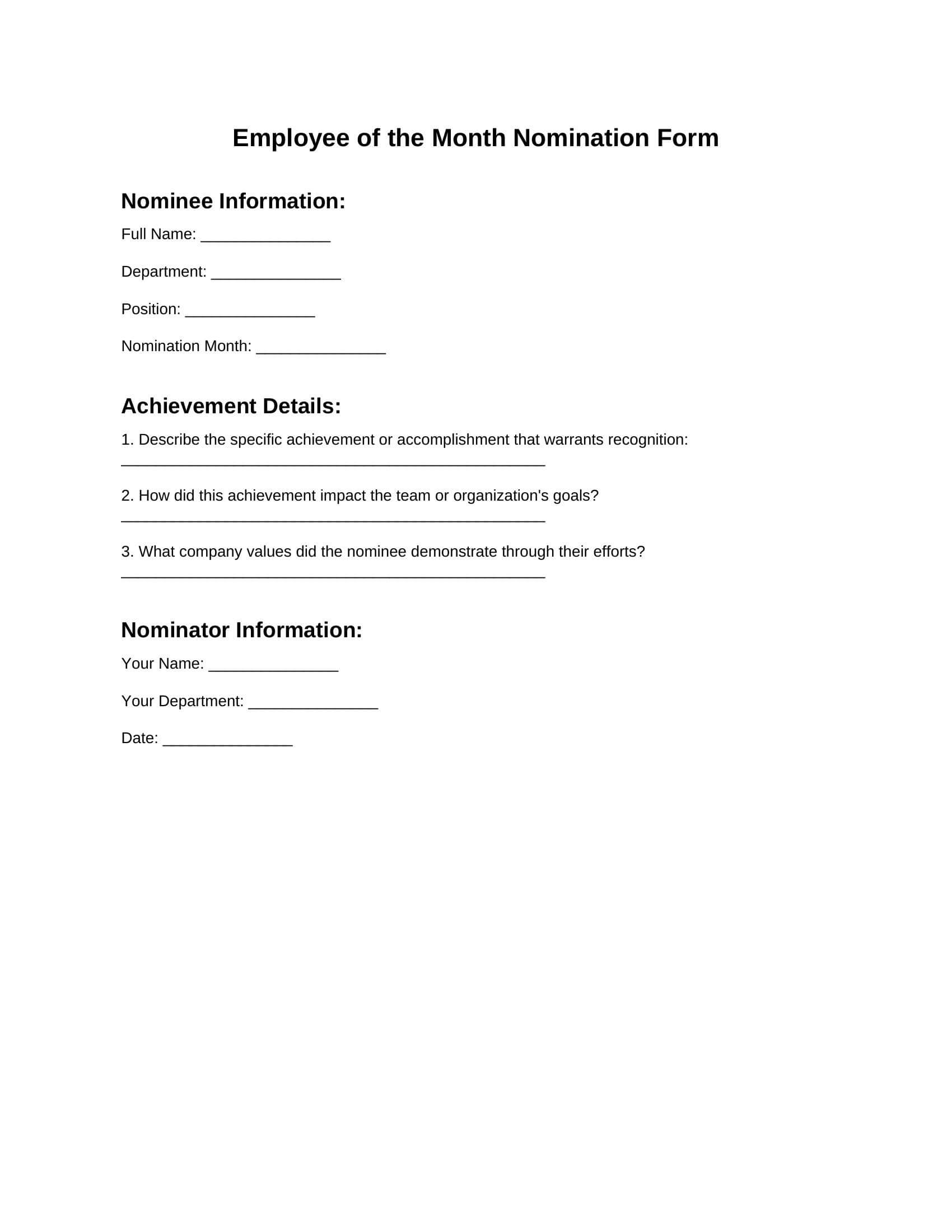
Link to: Employee_nomination_form_1.pdf
Template 2: Impact-Based Employee Nomination Form
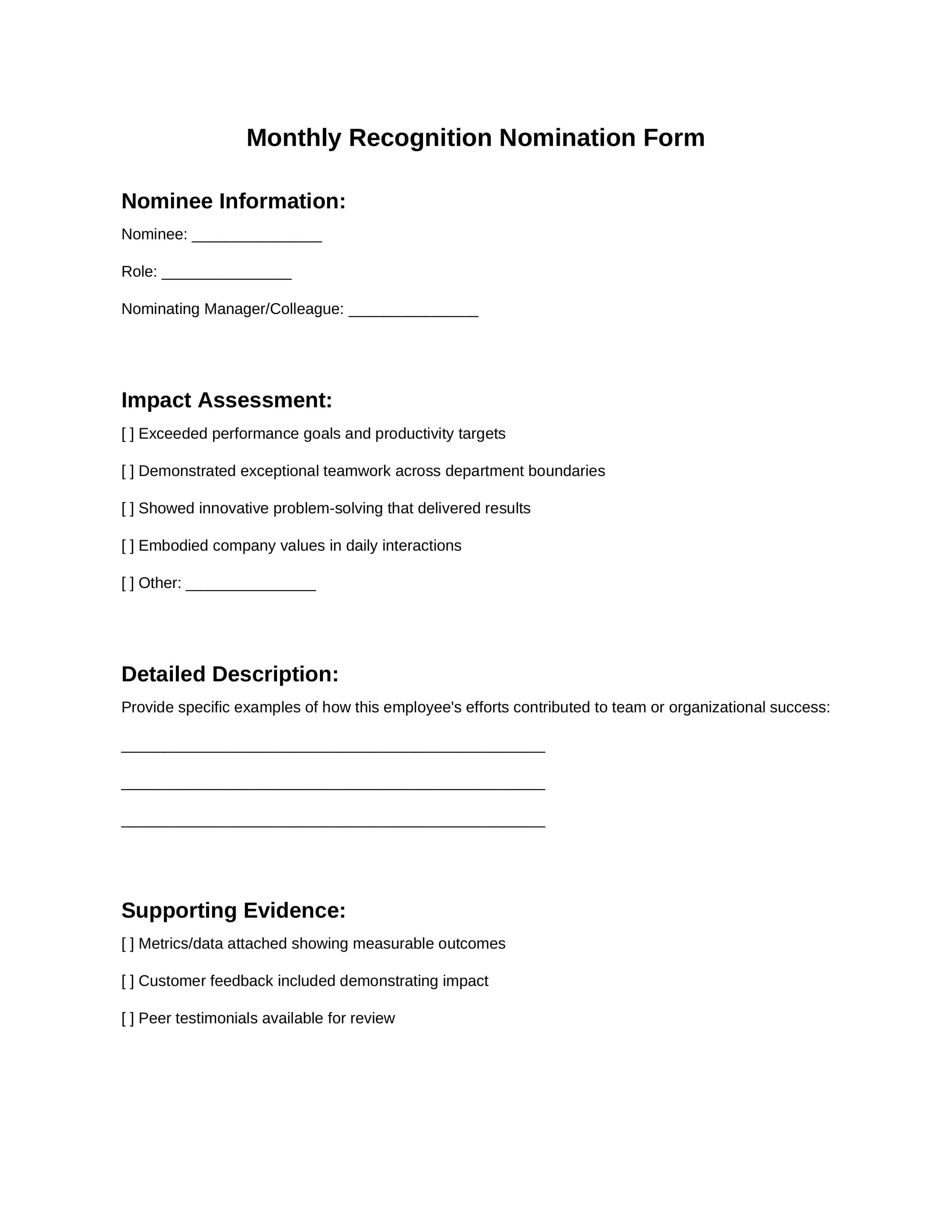
Link to: Employee_nomination_form_2.pdf
Template 3: Comprehensive Performance Employee Nomination Form
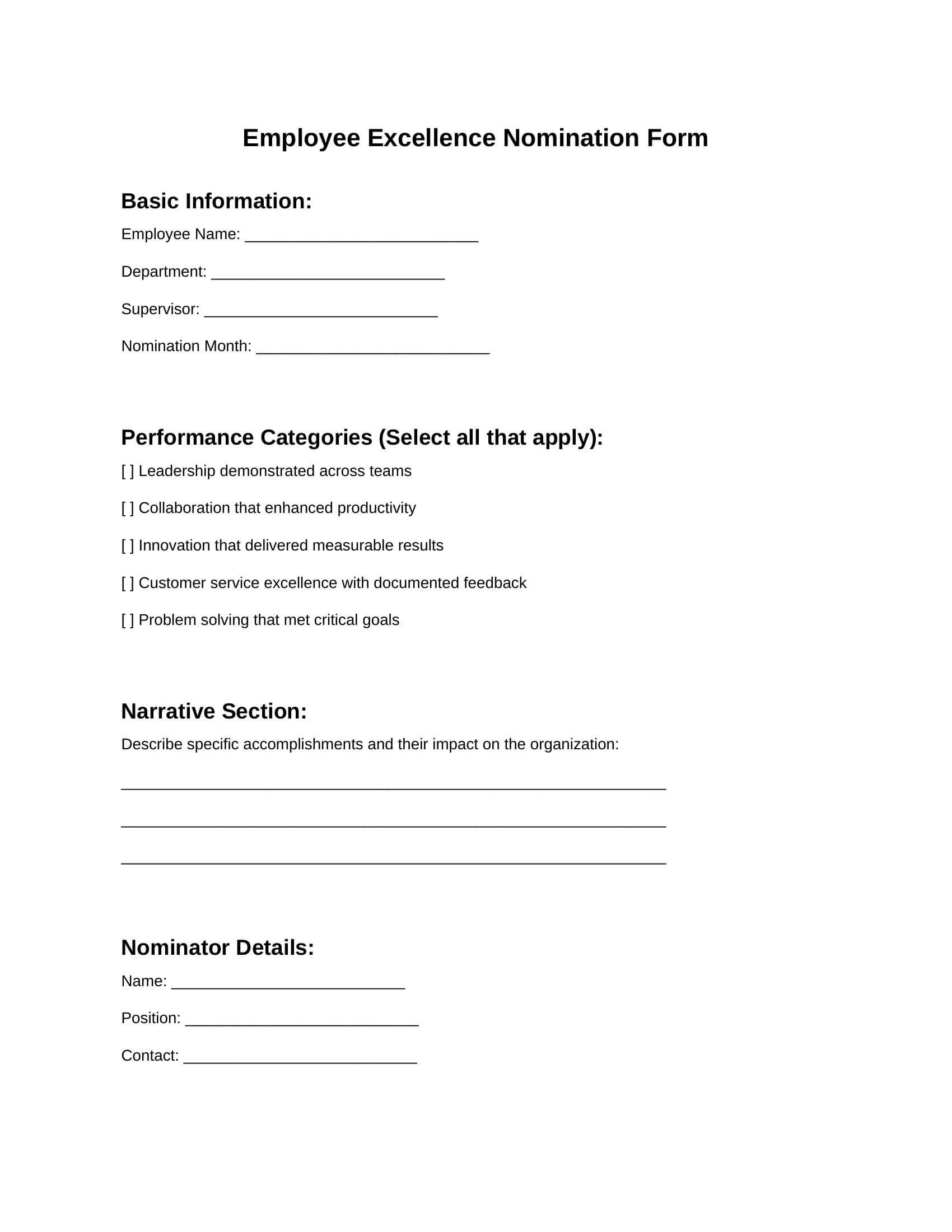
Link to: Employee_nomination_form_3.pdf
Template 4: Values-Driven Employee Nomination Form This template focuses on how employees embody organizational values through their daily work and exceptional contributions, with dedicated sections for describing value-aligned behaviors and their impact on department culture. Organizations often pair this with employee award nomination examples to guide nominators.
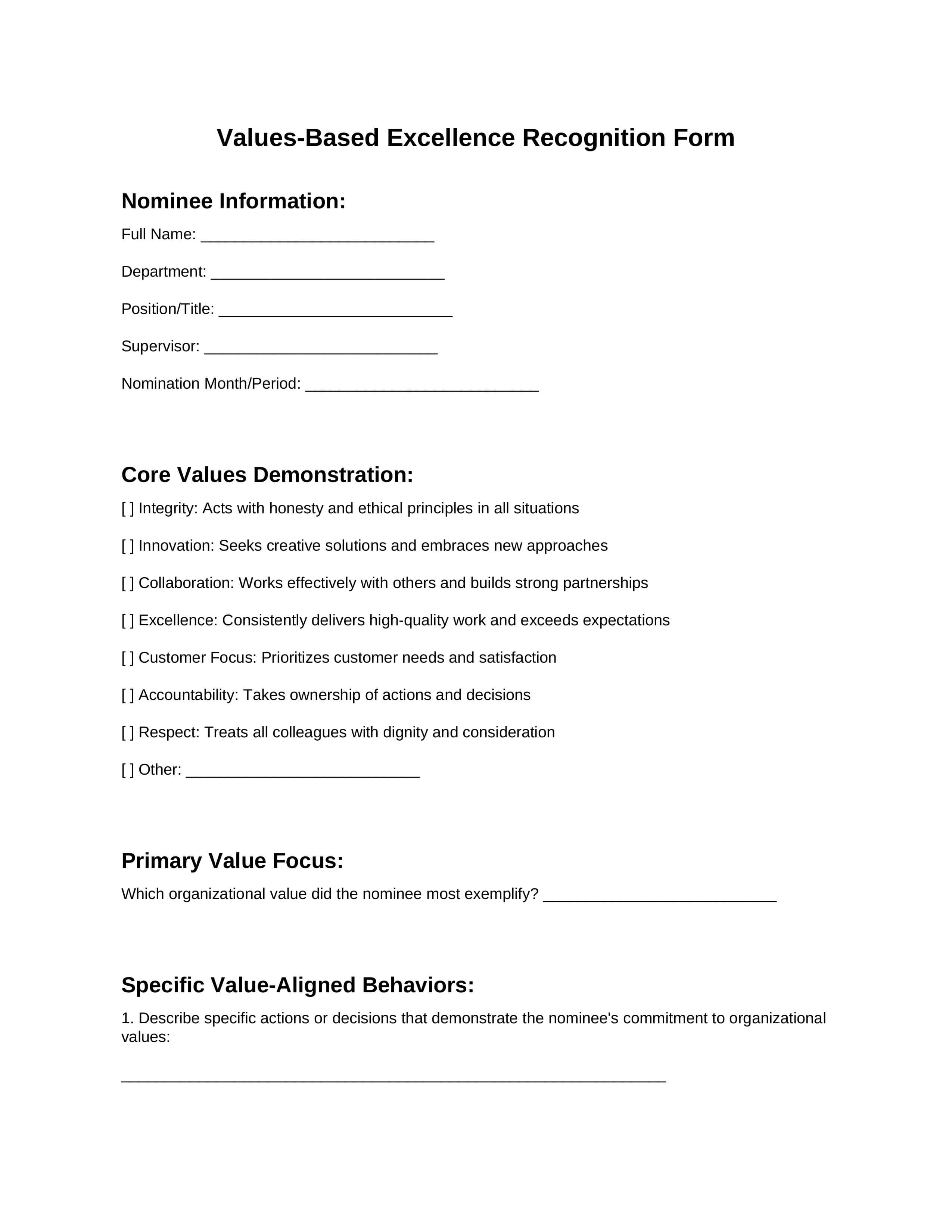
Link to: Employee_nomination_form_4.pdf
Template 5: Project-Specific Recognition Form
Designed for recognizing outstanding contributions to specific initiatives, departments, or cross-functional projects that require collaboration and deliver measurable outcomes.
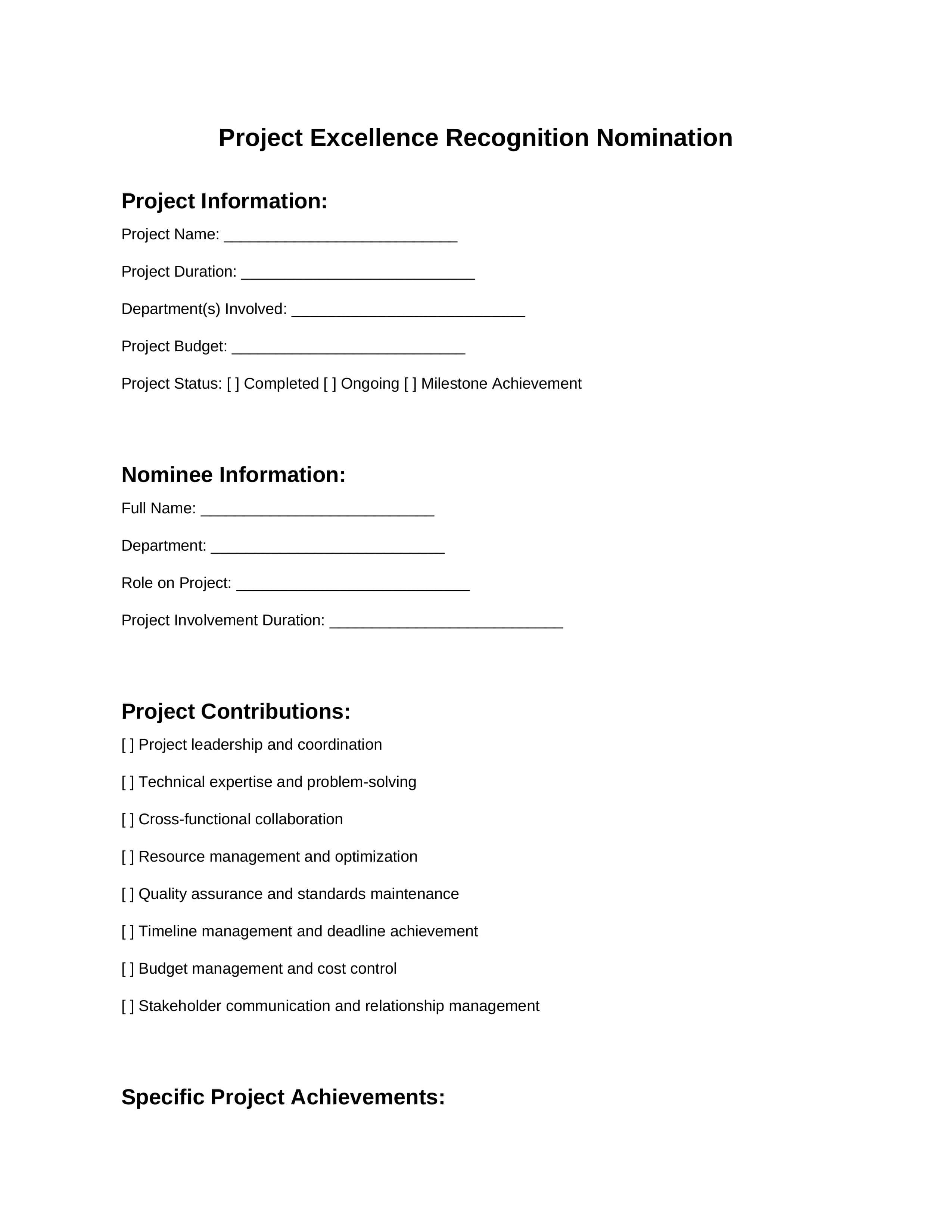
Link to: Employee_nomination_form_5.pdf
Template 6: Customer Service Excellence Form Tailored for service-oriented organizations where customer interaction and satisfaction represent key performance indicators, with sections for customer feedback and service delivery metrics.
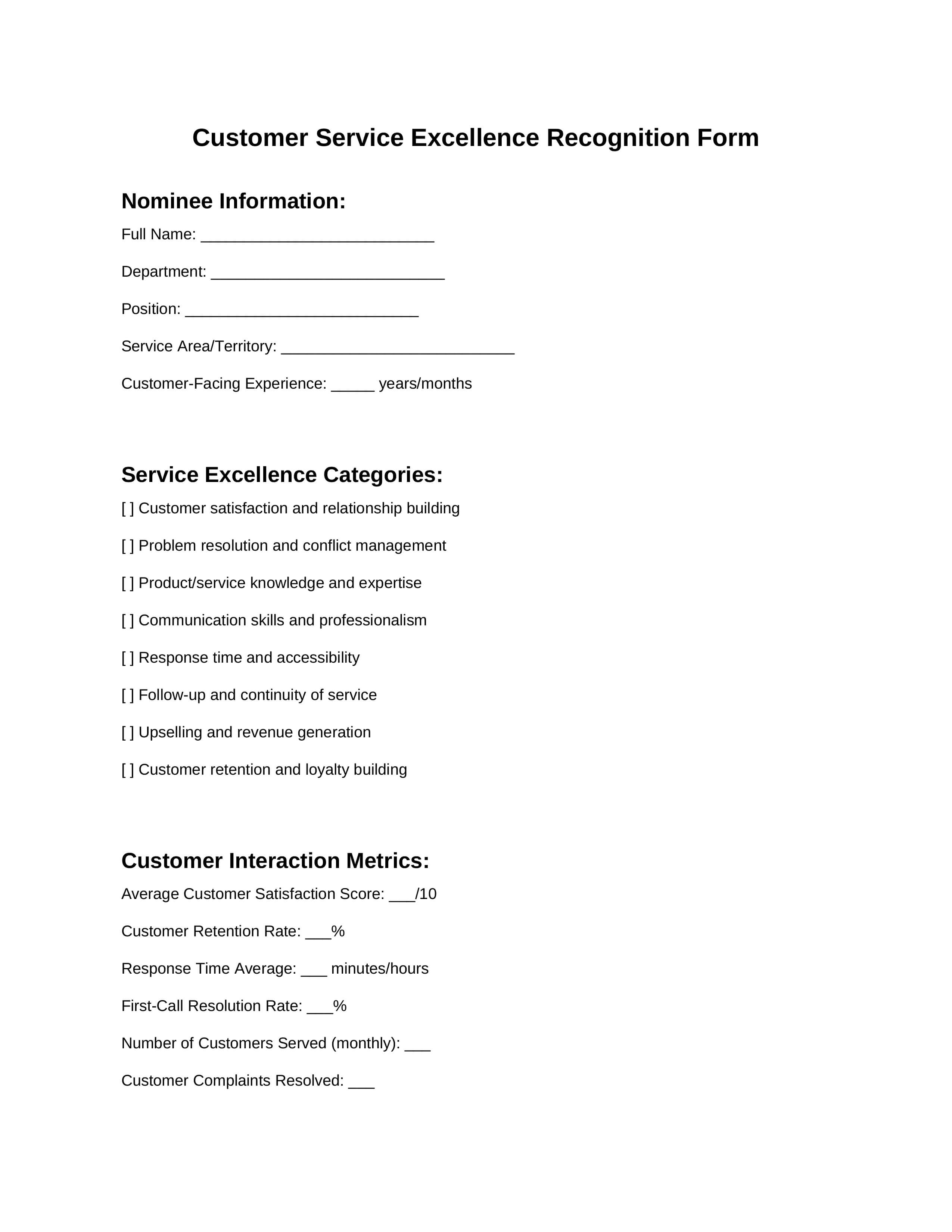
Link to: Employee_nomination_form_6.pdf
Template 7: Innovation and Creativity Recognition Template Focused on recognizing employees who contribute innovative solutions, creative approaches, or process improvements that enhance productivity and meet organizational goals.
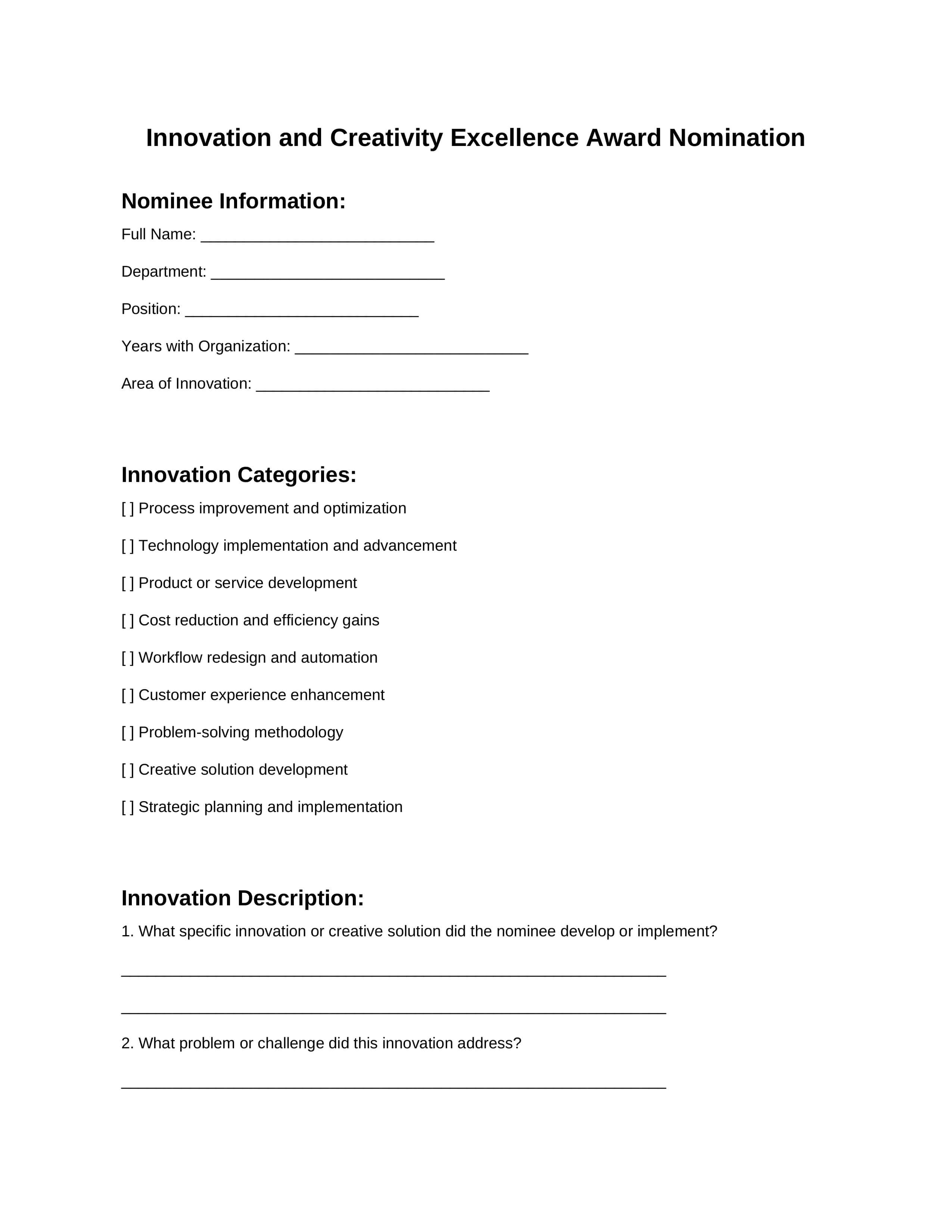
Link to: Employee_nomination_form_7.pdf
6 printable employee of the month nomination form formats
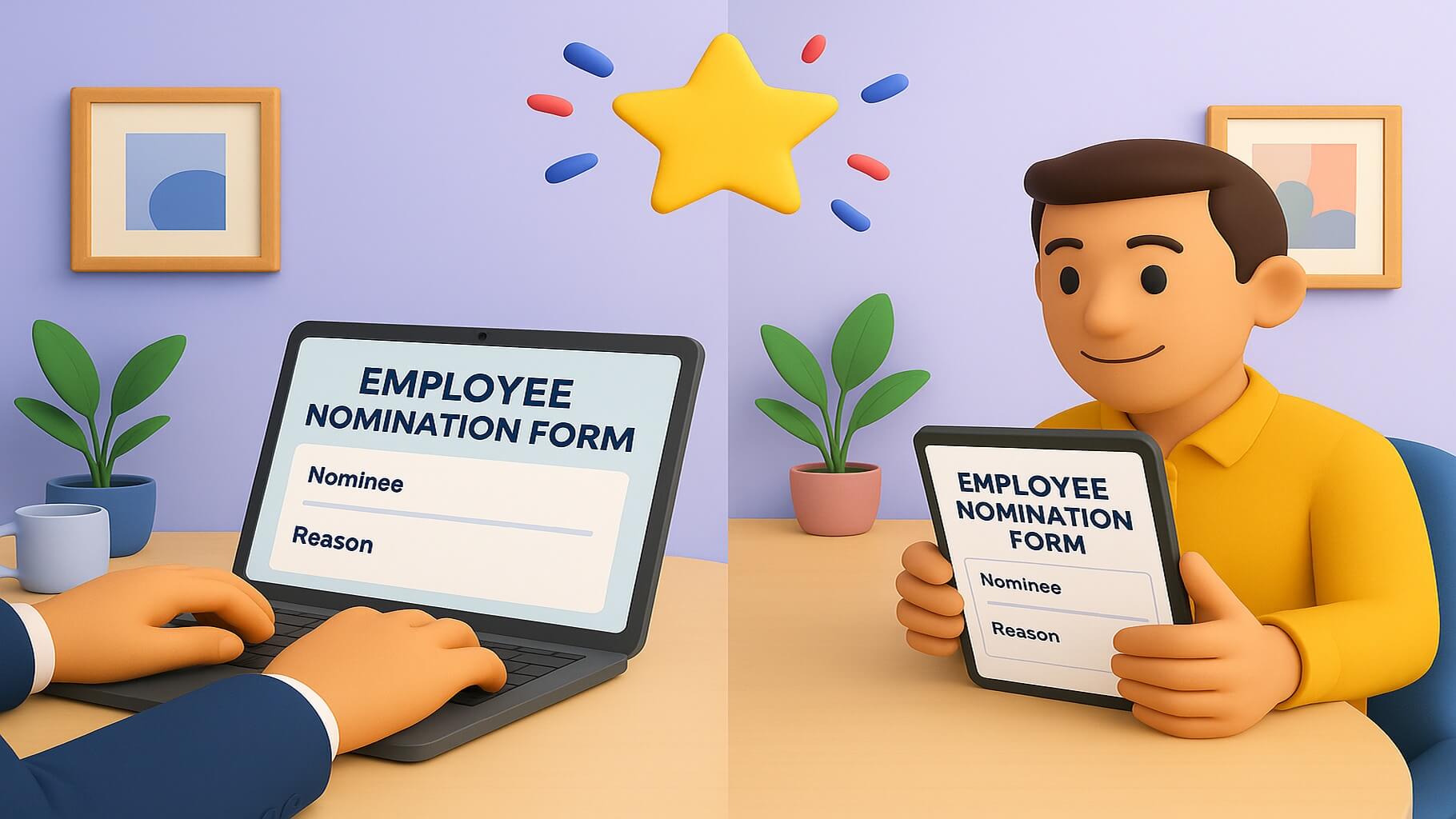
Format 1: Single-Page Condensed Employee Nomination Form A streamlined printable employee of the month nomination form that fits all essential information on one page, perfect for organizations with high nomination volumes or limited administrative time. This format includes core sections for nominee details, achievement description, and nominator information while maintaining accessibility for all staff members. Many organizations combine this with employee of the month nomination ideas to help nominators understand what makes compelling submissions.
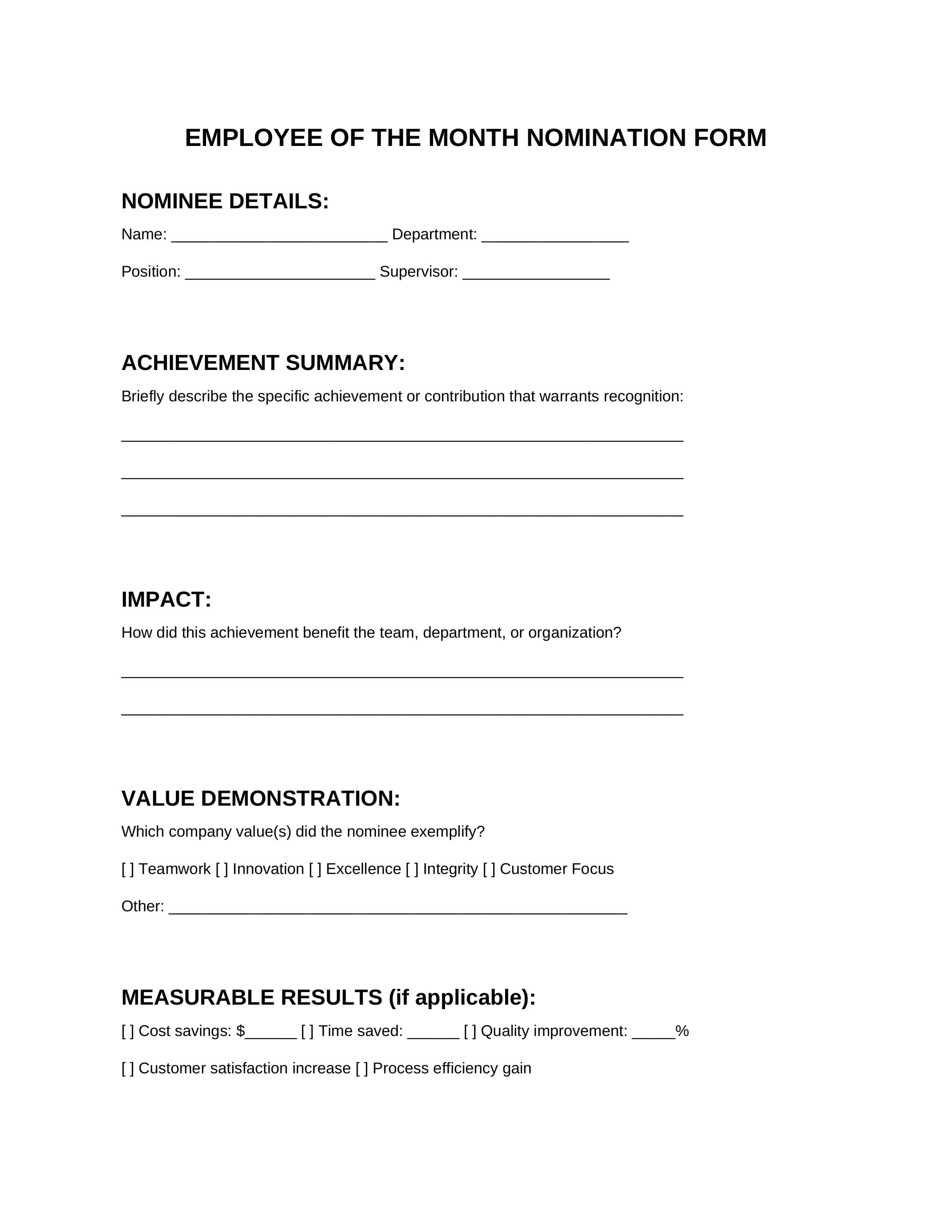
Link to: Employee_nomination_form_8.pdf
Format 2: Multi-Section Detailed Form A comprehensive two-page format that allows for extensive descriptions of employee efforts and achievements while maintaining clear organization and professional appearance. This form includes dedicated sections for each evaluation criterion and provides space for detailed examples that support award consideration.
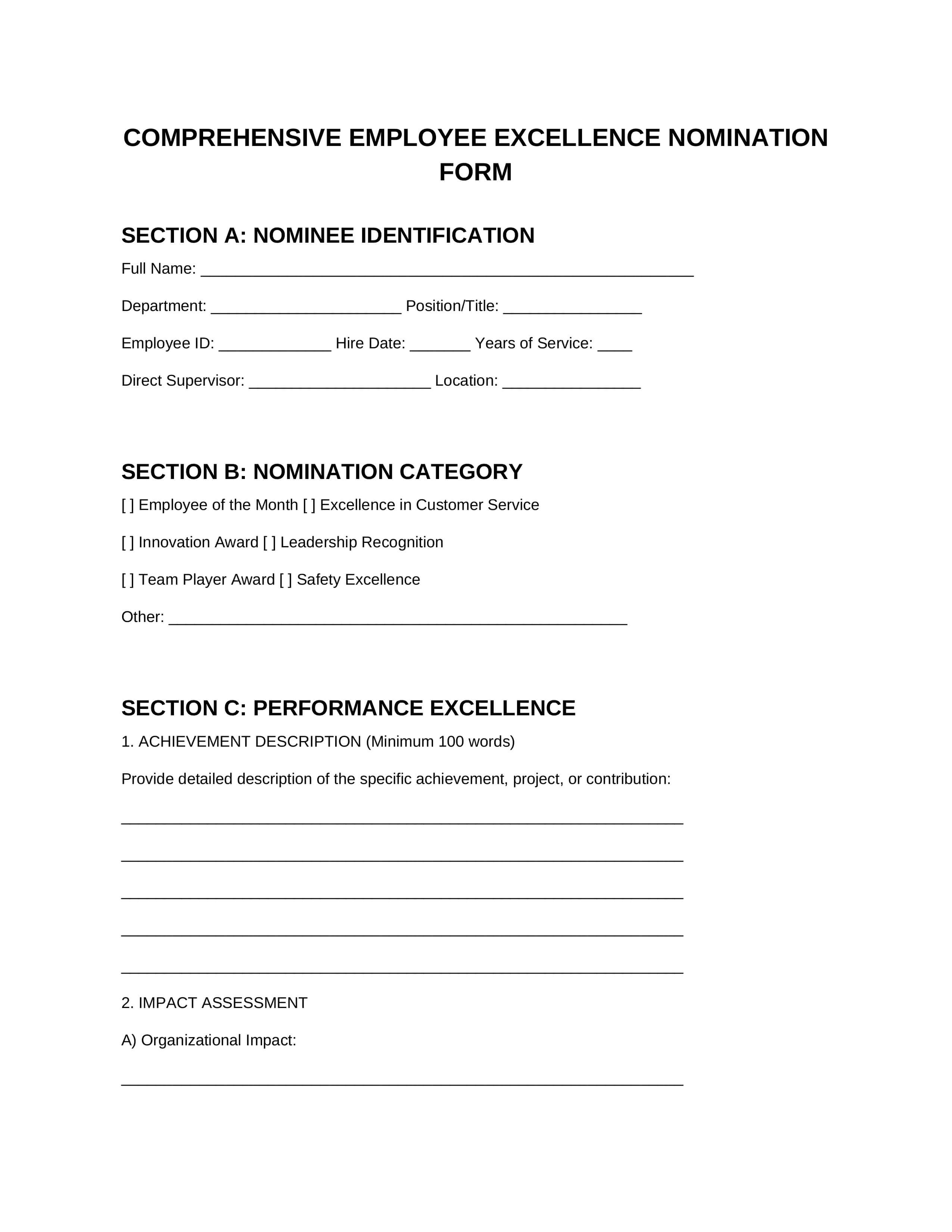
Link to: Employee_nomination_form_9.pdf
Format 3: Checkbox-Style Quick Form Features multiple checkbox options for common achievements and a smaller narrative section, enabling fast completion while ensuring consistent information collection across departments. This format supports efficient voting processes and streamlined review procedures.
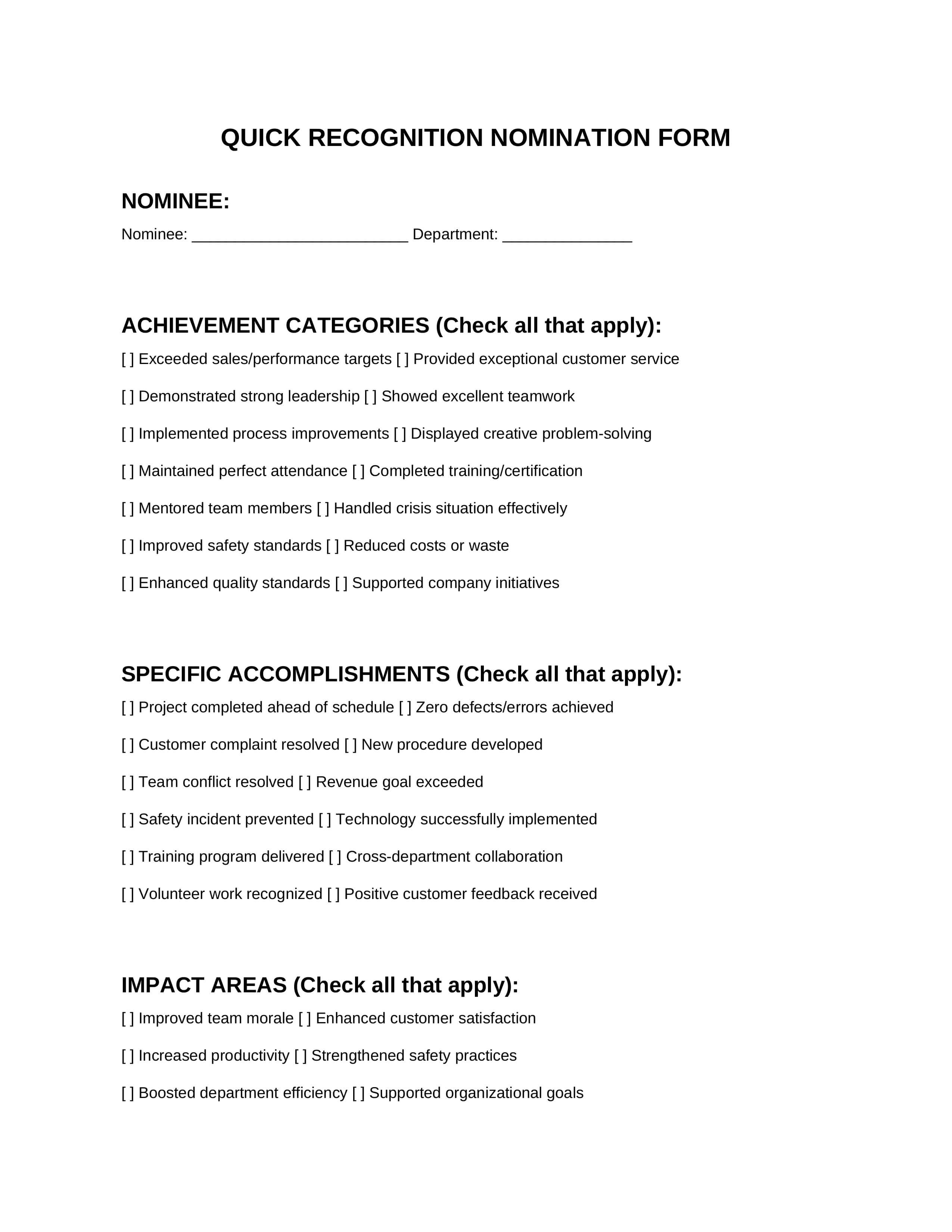
Link to: Employee_nomination_form_10.pdf
Format 4: Department-Specific Template Customizable forms that can be adapted for different departments, with role-specific performance criteria and relevant achievement categories that reflect unique workplace responsibilities and goals.
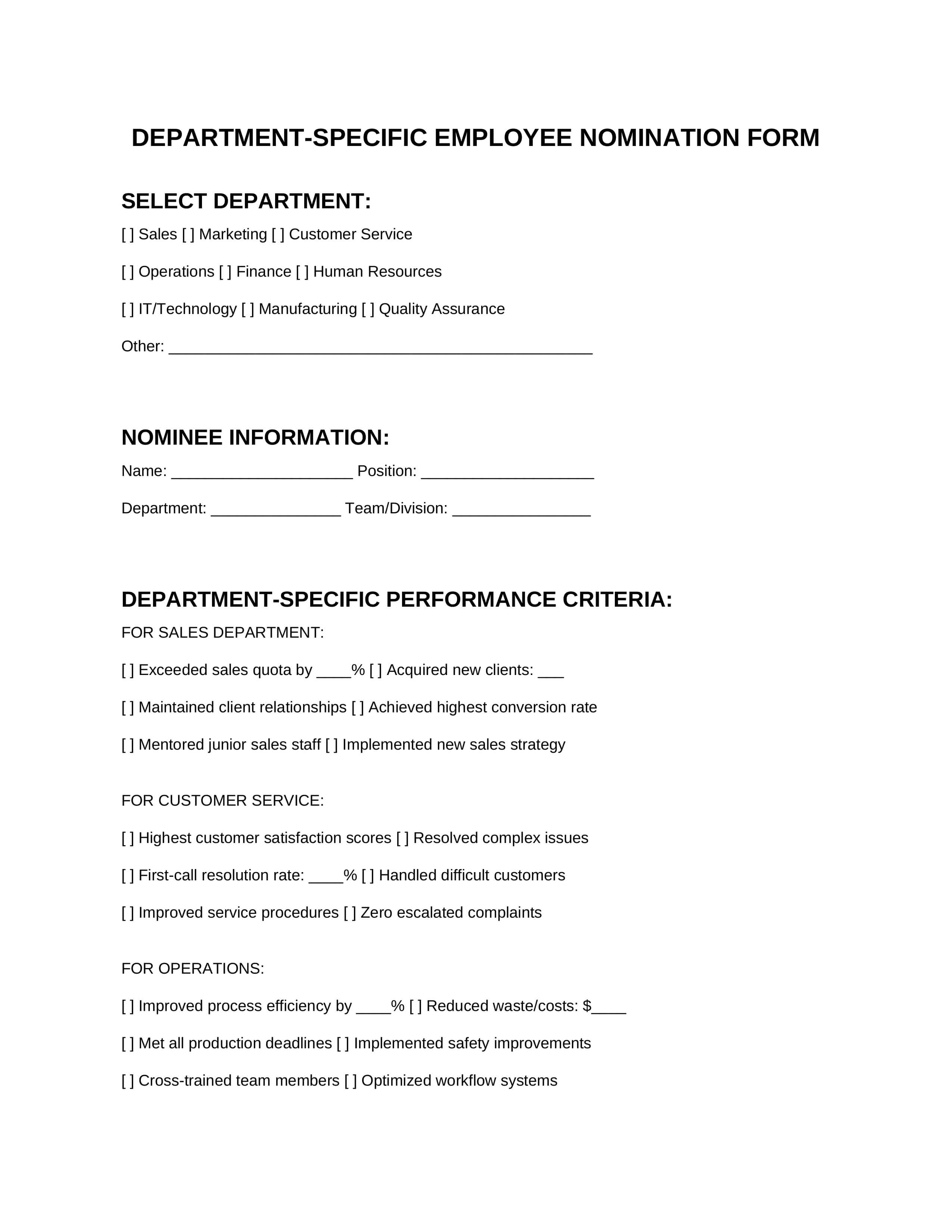
Link to: Employee_nomination_form_11.pdf
Format 5: Peer Nomination Focus Form Designed specifically for peer-to-peer nominations with language and criteria that encourage colleagues to recognize each other's contributions and celebrate collaborative efforts across teams.
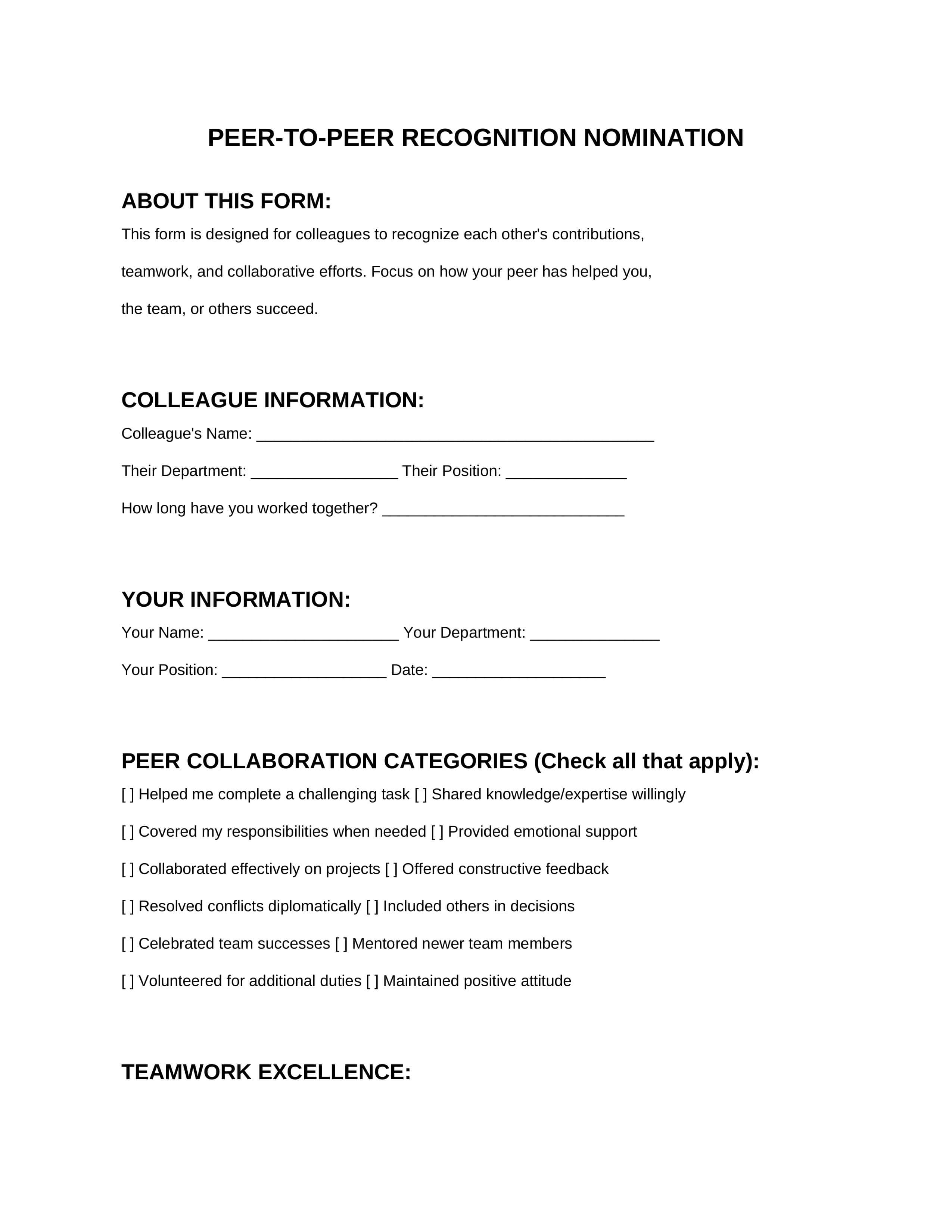
Link to: Employee_nomination_form_12.pdf
Format 6: Manager Employee Nomination Form Template Structured for supervisory nominations with sections for performance metrics, goal achievement, and leadership demonstration that support comprehensive evaluation and fair decision making.
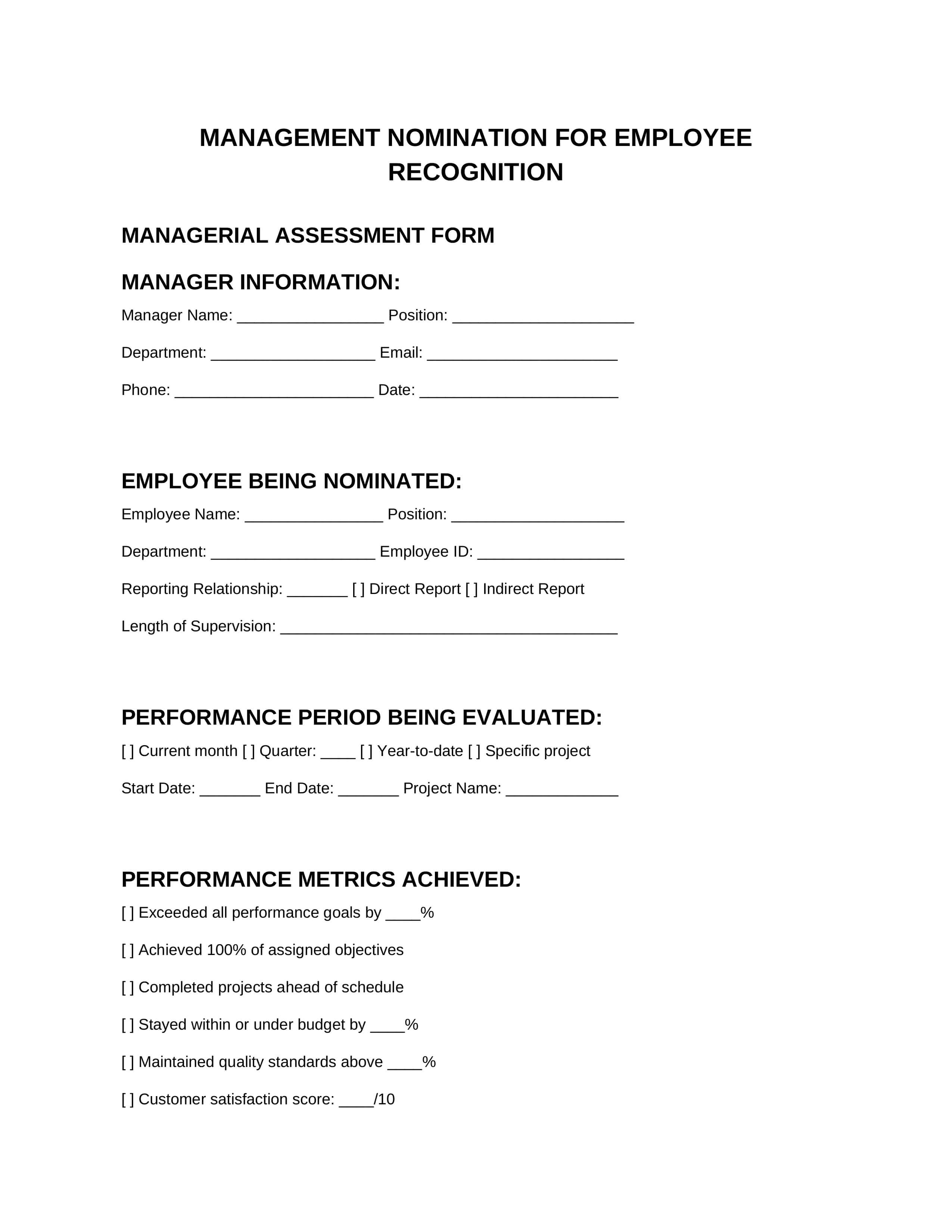
Link to: Employee_nomination_form_13.pdf
7 additional employee recognition nomination form examples
Additional employee recognition nomination form examples provide organizations with specialized templates that address unique recognition scenarios and organizational needs across departments and teams. These supplementary forms complement standard nomination processes by offering targeted approaches for specific types of achievements, diverse workplace situations, and varying levels of detail required for different award categories. Well-designed additional forms ensure that organizations can capture meaningful recognition opportunities that might not fit traditional nomination templates while maintaining consistency in evaluation and decision-making processes.
Modern organizations benefit from having diverse nomination form options that accommodate different recognition preferences, submission methods, and evaluation criteria while supporting comprehensive employee incentive programs and recognition initiatives. These specialized templates help ensure that all exceptional contributions receive appropriate documentation and consideration, regardless of the specific circumstances or achievement types involved. Organizations often find that supplementary forms increase participation rates by providing accessible options for various nomination scenarios and employee populations across communities and staff groups.
Form examples that address diverse recognition needs
Form 1: Comprehensive Employee Excellence Template This detailed form captures exceptional performance across multiple categories, including consistent excellence, professional development, and innovation. It provides extensive sections for documenting achievements, measuring impact, and gathering supporting evidence that demonstrates sustained high performance over time.
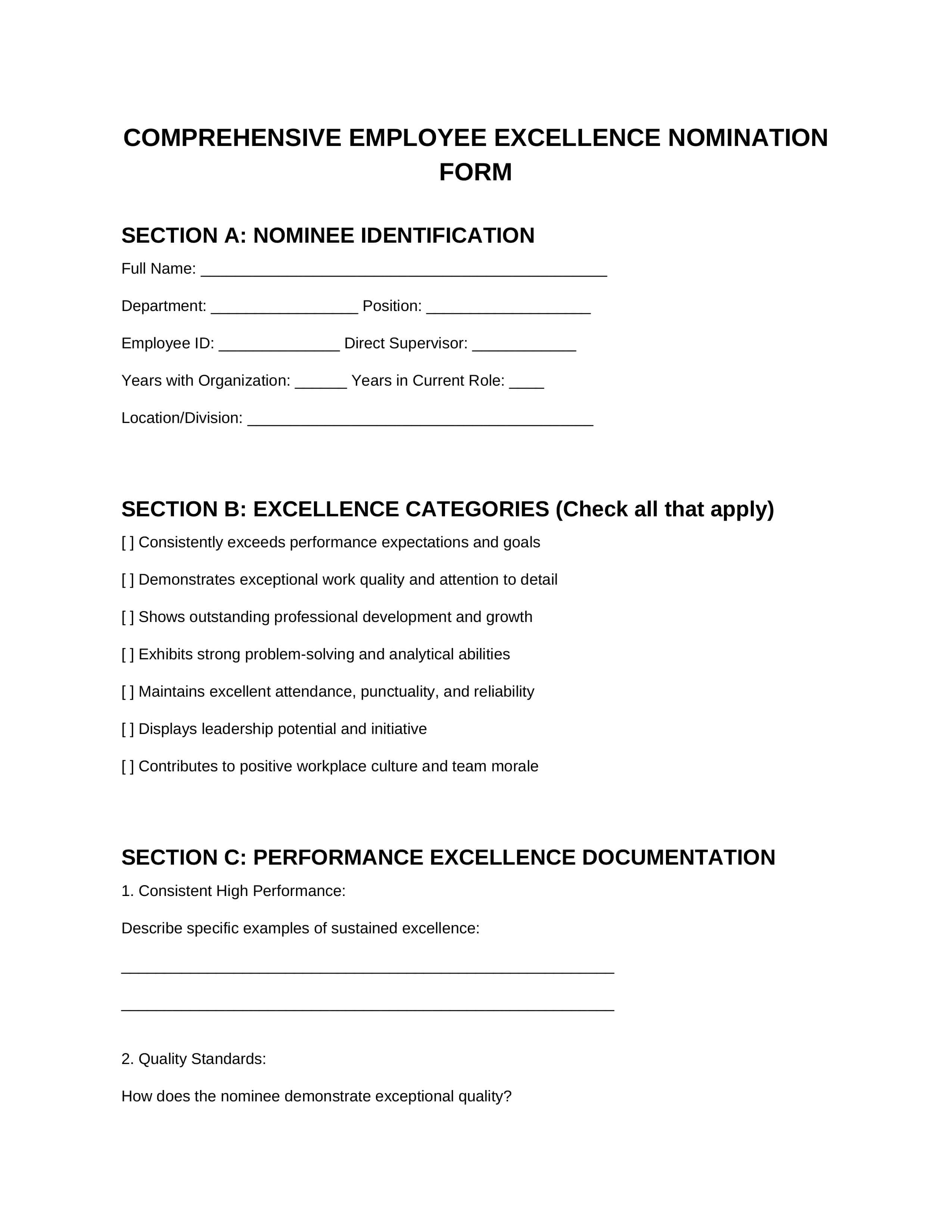
Link to: Employee_nomination_form_14.pdf
Form 2: Quick Recognition Form A streamlined template designed for rapid submission of time-sensitive recognition while maintaining essential information collection requirements. This form enables immediate acknowledgment of achievements while ensuring that important details are captured efficiently for review and voting processes.
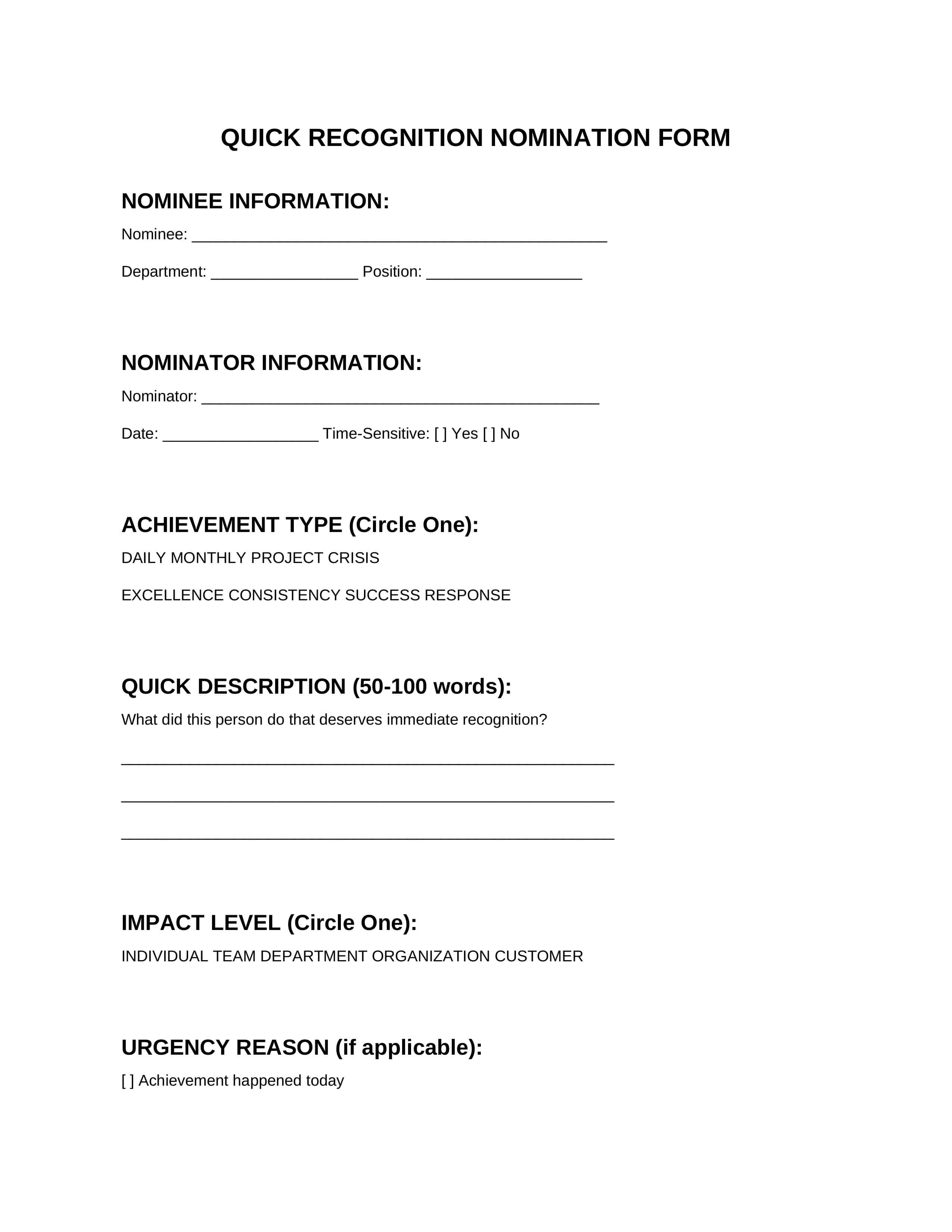
Link to: Employee_nomination_form_15.pdf
Form 3: Structured Data Collection Template Organized for systematic information gathering with standardized questions and measurable criteria that support consistent evaluation across all submissions. This format ensures that reviewers receive comparable information for fair decision-making while accommodating various achievement types and organizational goals.
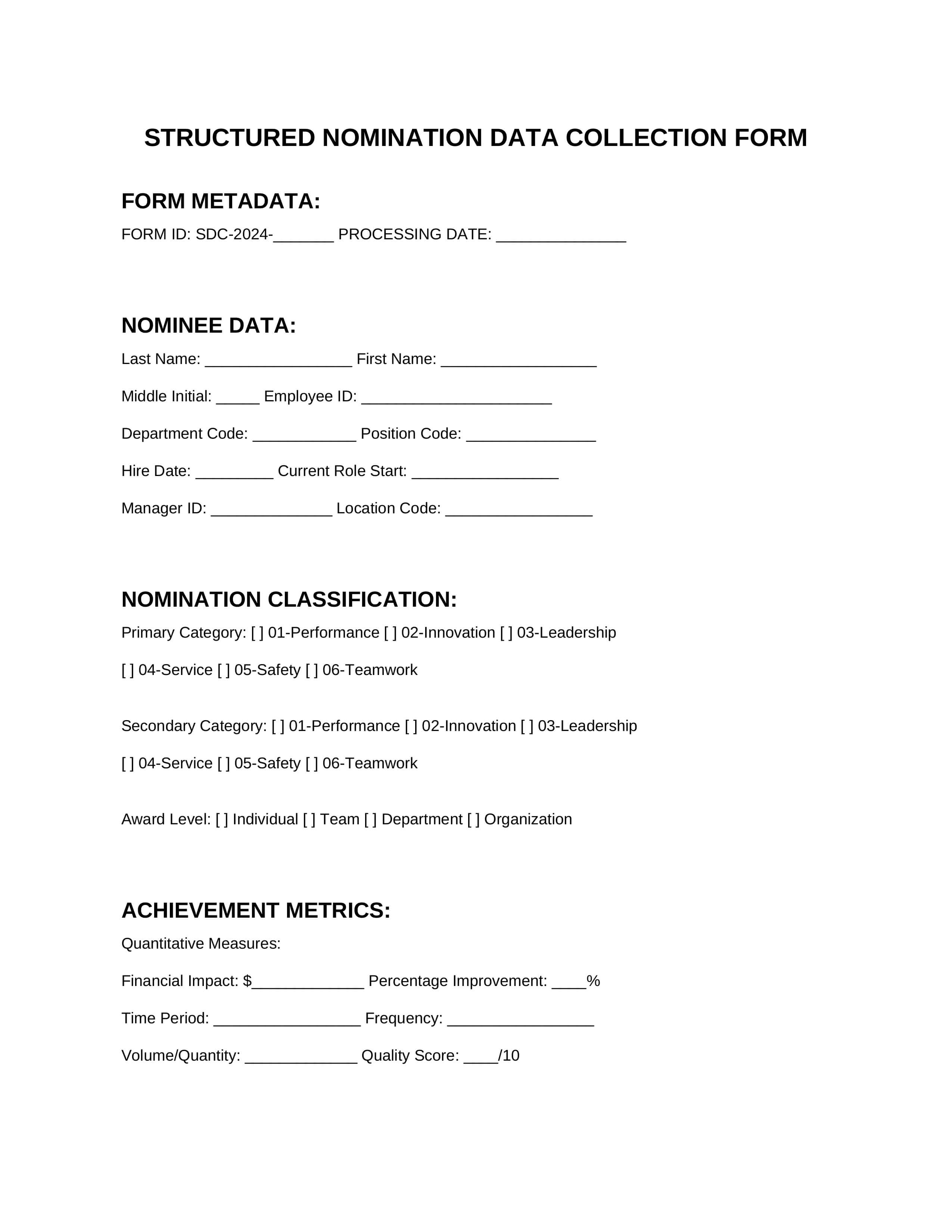
Link to: Employee_nomination_form_16.pdf
Form 4: Performance Integration Template Designed to connect recognition efforts with existing performance management systems and career development initiatives while supporting long-term employee growth objectives. This form captures achievements in the context of individual development plans and organizational succession planning efforts.
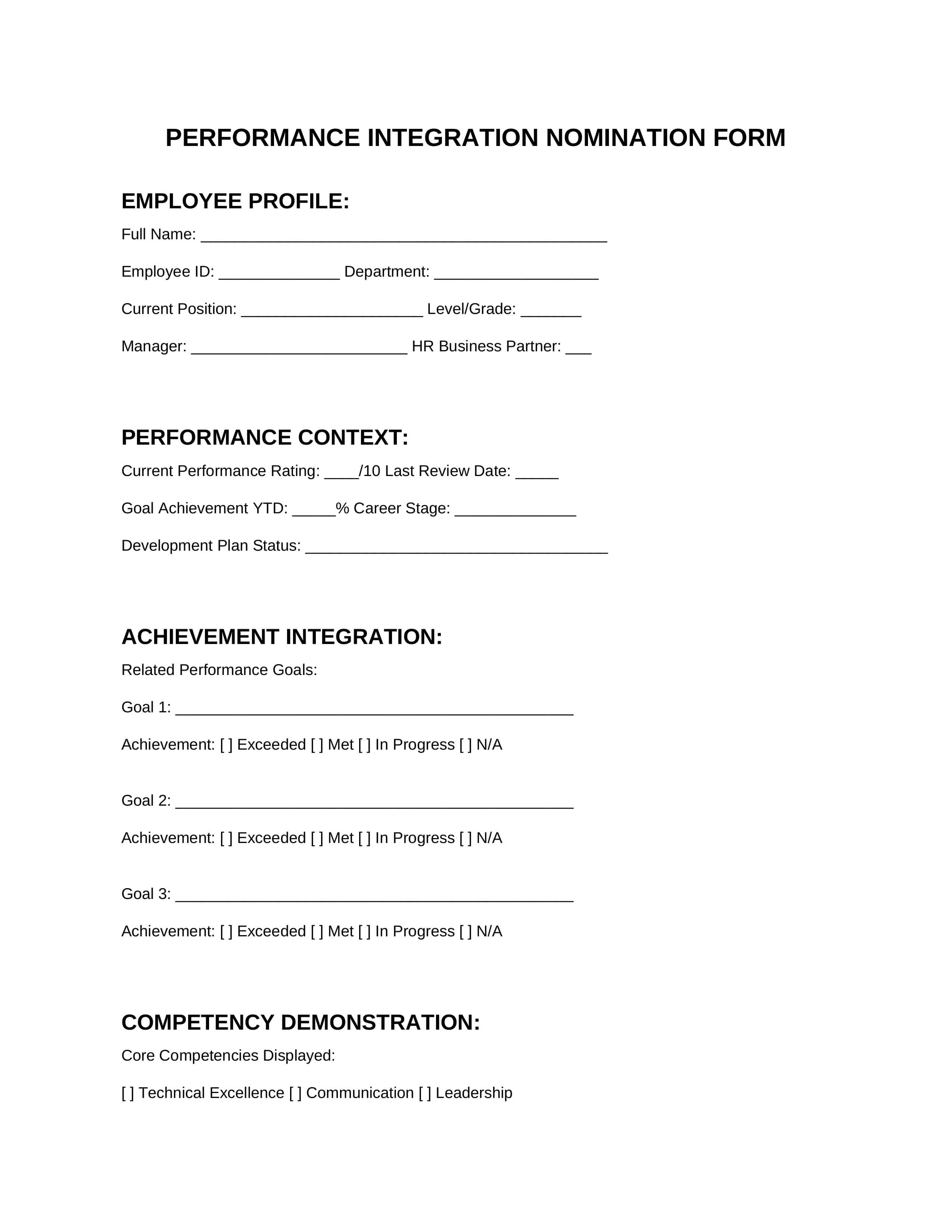
Link to: Employee_nomination_form_17.pdf
Form 5: Anonymous Submission Template Provides confidential nomination capabilities for sensitive situations while maintaining the integrity of the recognition process and ensuring fair consideration of all contributions. This form protects the nominator's identity while gathering essential information for committee review and decision-making procedures.
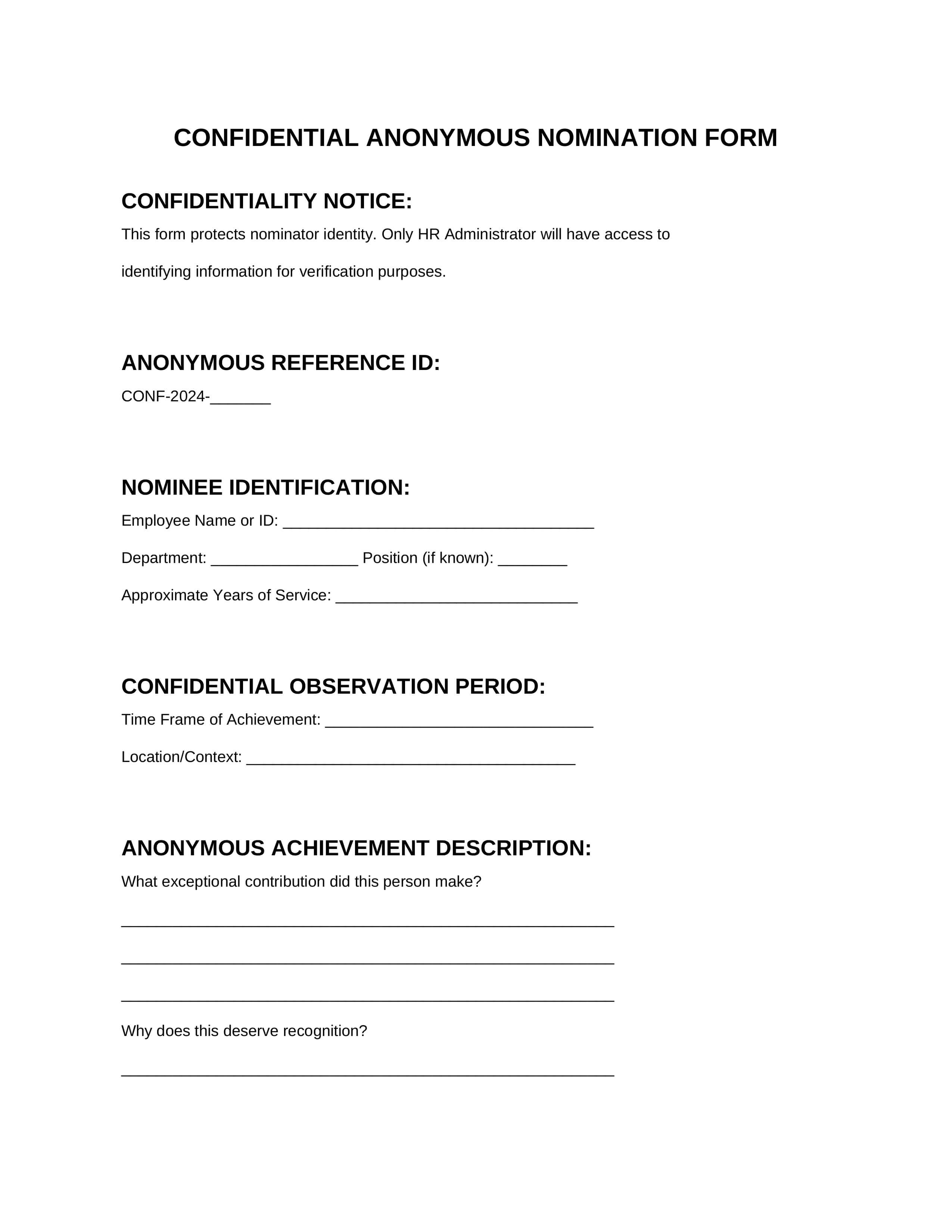
Link to: Employee_nomination_form_18.pdf
Form 6: Multi-Cultural Recognition Template Accommodates diverse workforces with culturally appropriate recognition categories and language considerations that serve global organizations and multicultural communities. This form ensures that recognition practices respect different cultural values and communication preferences while maintaining consistent evaluation standards.

Link to: Employee_nomination_form_20.pdf
Form 7: Achievement Metrics Template Focuses on quantifiable results and measurable impact with dedicated sections for data collection, trend analysis, and performance indicators that support data-driven recognition decisions. This form emphasizes objective criteria and concrete evidence that demonstrates exceptional contribution value to organizational success.
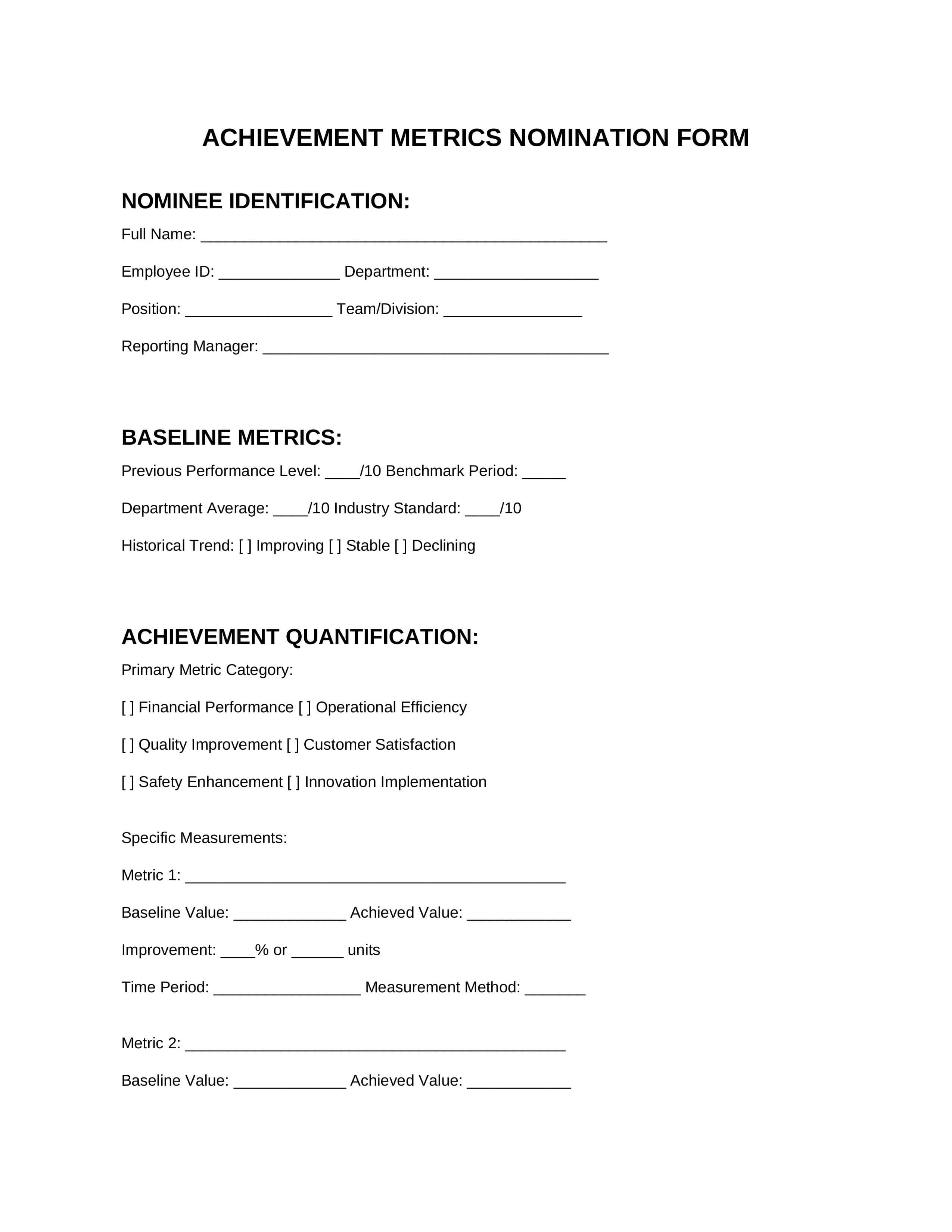
Link to: Employee_nomination_form_21.pdf
15 employee of the month nomination form examples across industries
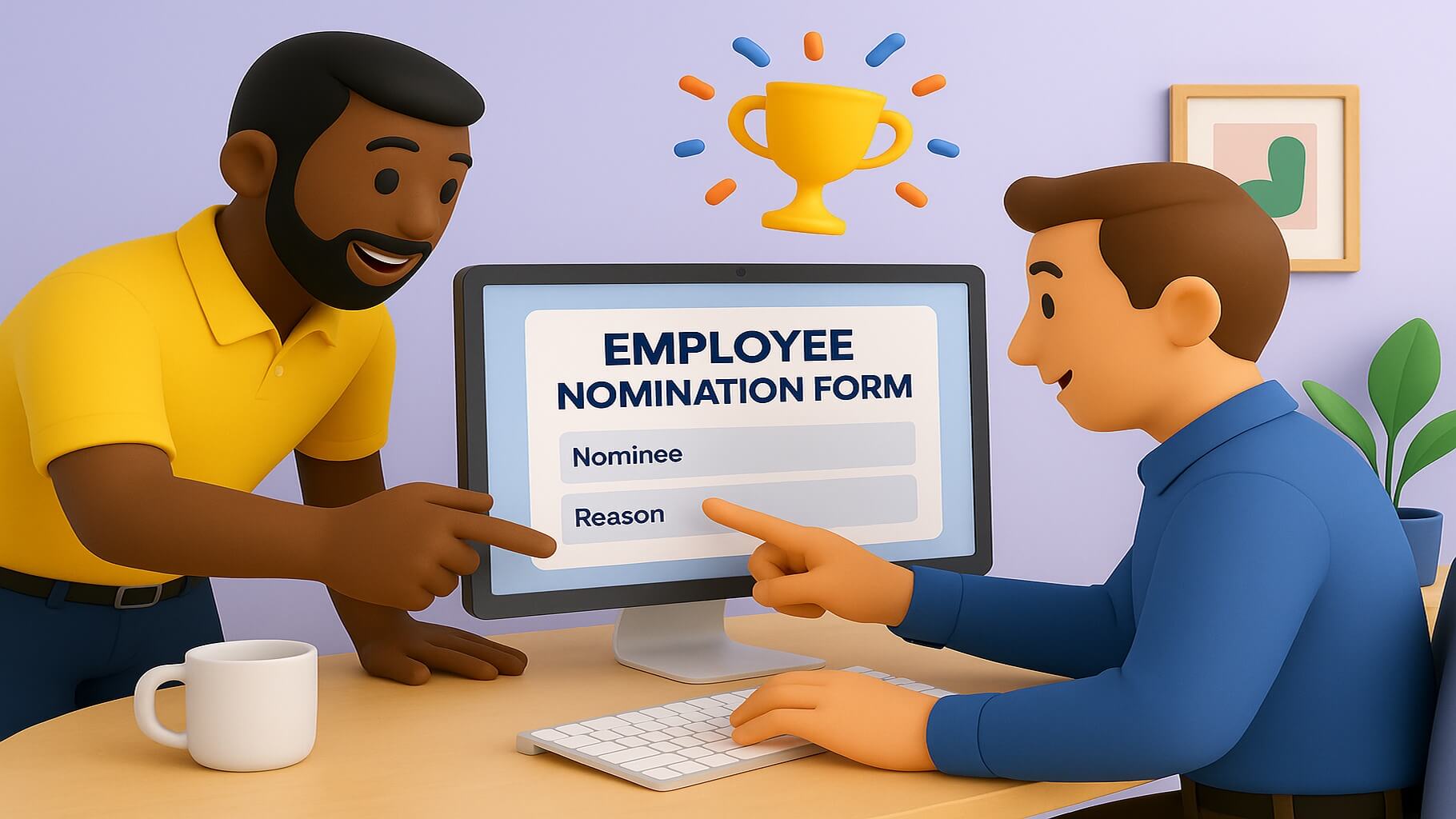
Industry-specific employee of the month nomination form templates address unique workplace environments, performance metrics, and recognition criteria that vary across different sectors and communities. These specialized forms ensure that nomination processes capture relevant achievements while reflecting the distinct challenges and success factors within each industry. By tailoring nomination forms to specific industry needs, organizations create more meaningful recognition experiences that resonate with employees and stakeholders while supporting sector-specific goals and productivity targets.
The following examples demonstrate how organizations across various sectors can adapt standard nomination forms to meet their unique operational requirements and cultural expectations. Each template incorporates industry-specific language, performance indicators, and achievement categories that align with sector-specific goals and values while maintaining accessibility for all staff members and departments. Organizations often find value in reviewing nomination for employee of the month best practices before customizing industry-specific approaches.
5 healthcare and service sector nomination form for employee of the month
Healthcare Form 1: Patient Care Excellence Template
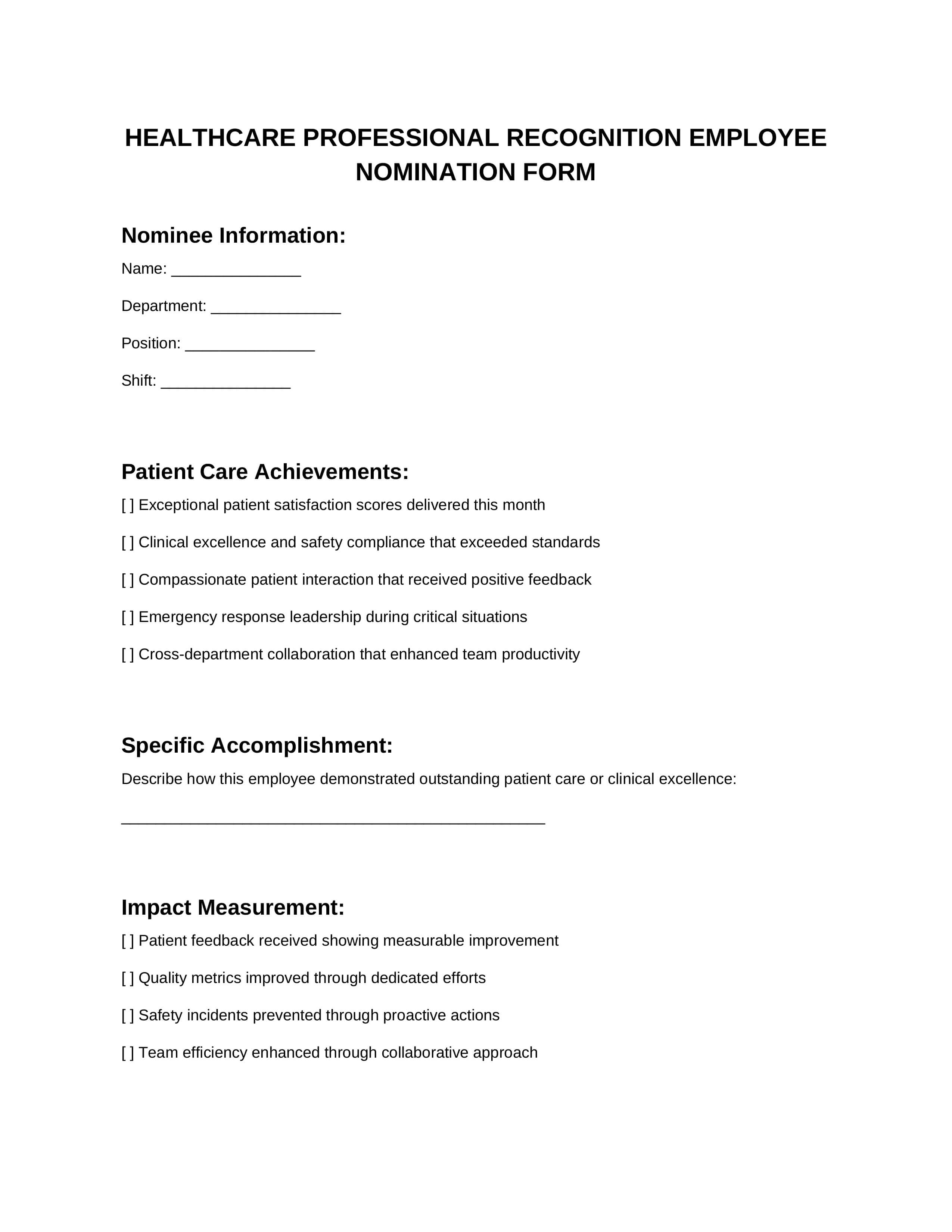
Link to: Employee_nomination_form_22.pdf
Healthcare Form 2: Safety and Compliance Focus Emphasizes adherence to healthcare regulations, patient safety protocols, and quality improvement initiatives that protect patients and staff while maintaining high standards across departments. This form includes sections for documenting compliance achievements and safety improvements that demonstrate exceptional duty to care. Healthcare organizations benefit from incorporating employee of the year nomination example principles for annual recognition programs.
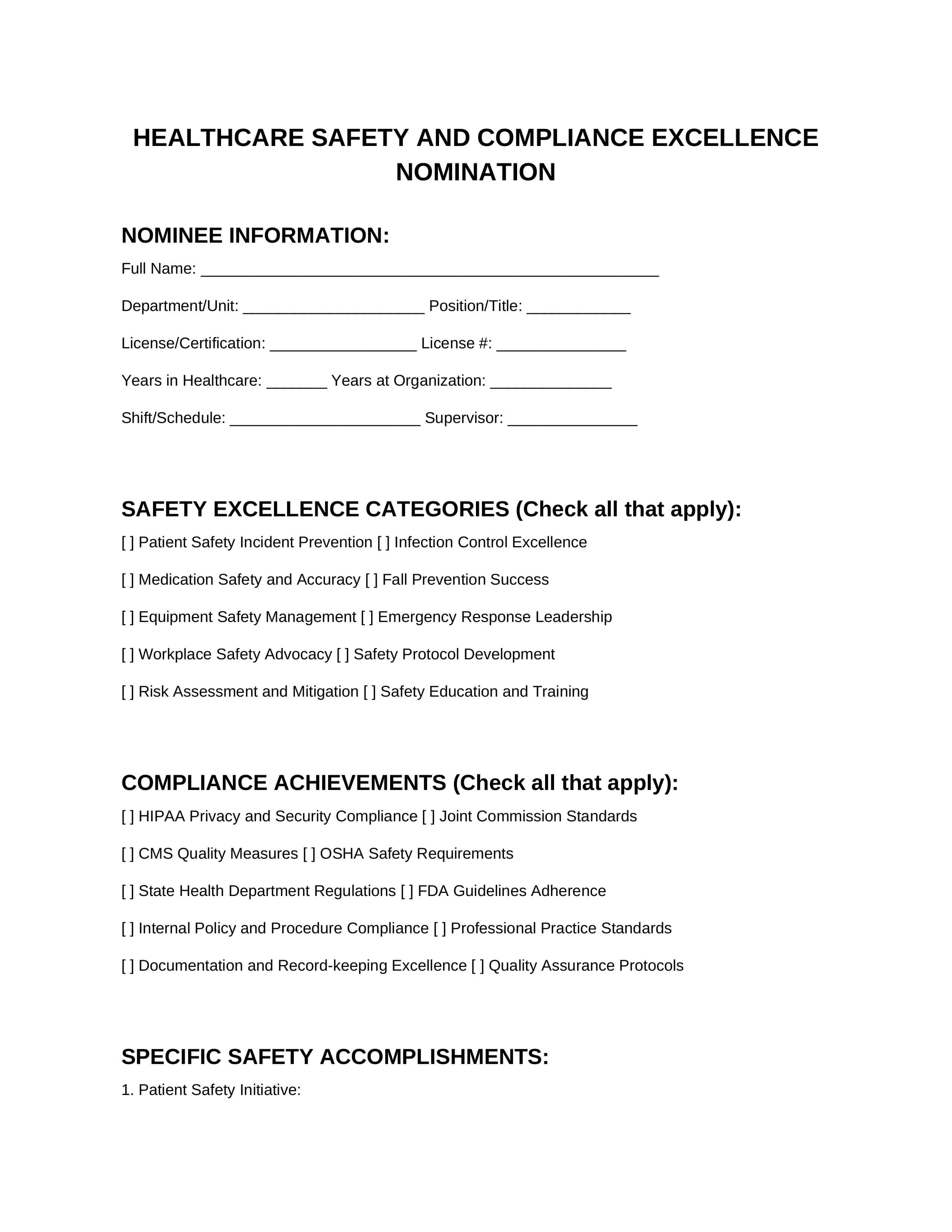
Link to: Employee_nomination_form_23.pdf
Healthcare Form 3: Team Collaboration Template Recognizes healthcare workers who excel in multidisciplinary care coordination, communication, and collaborative patient outcomes that enhance overall department effectiveness and patient satisfaction.
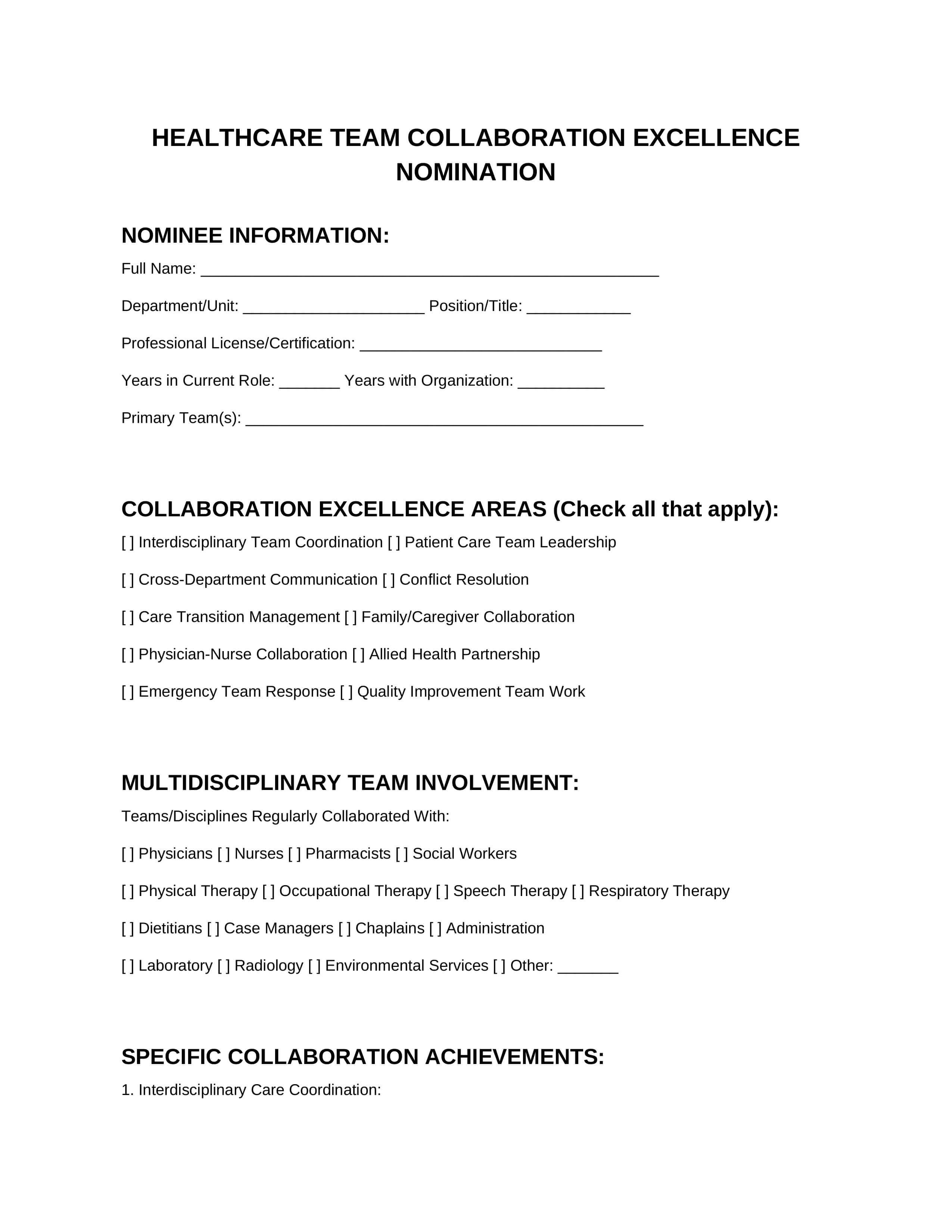
Link to: Employee_nomination_form_24.pdf
Service Sector Form 4: Customer Experience Excellence
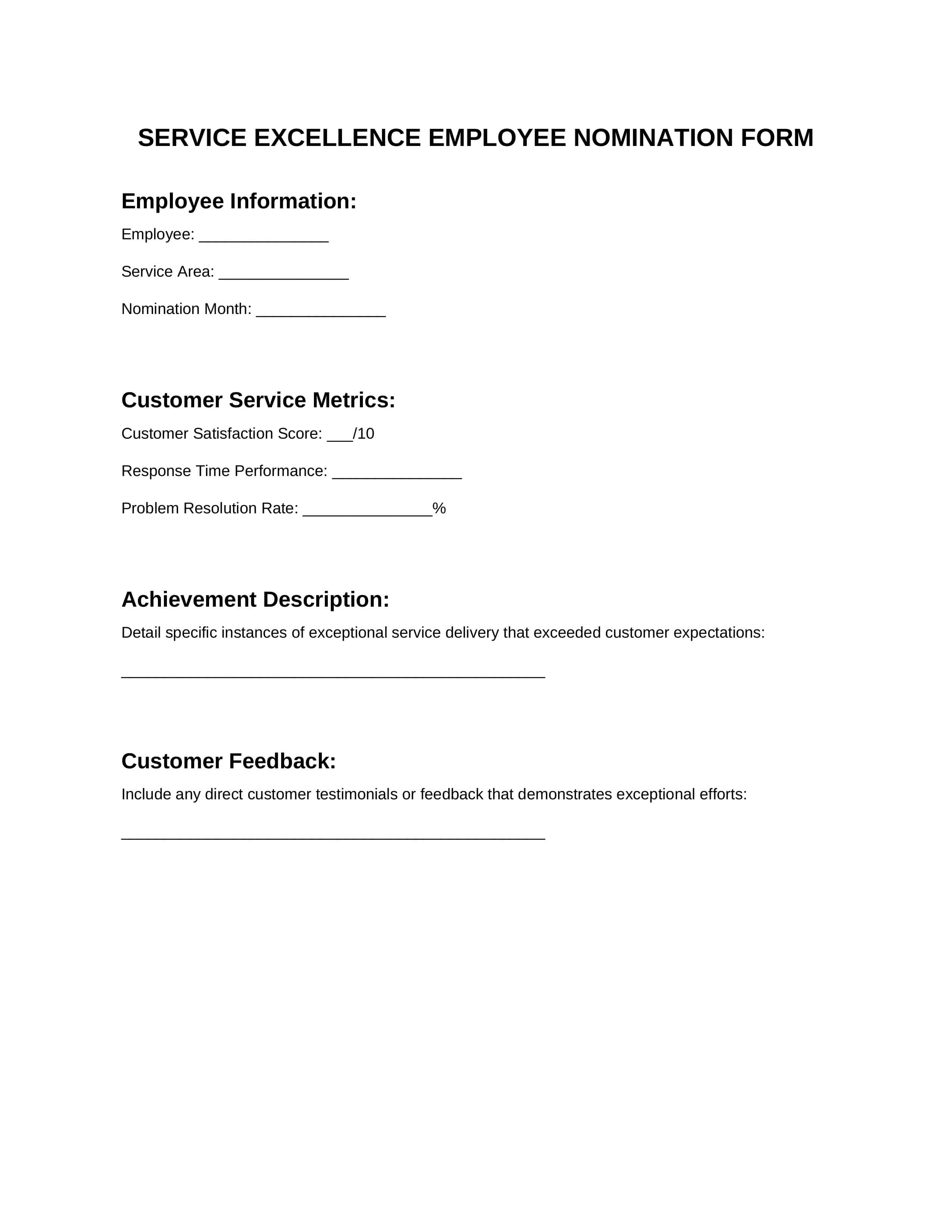
Link to: Employee_nomination_form_25.pdf
Service Sector Form 5: Innovation in Service Delivery Focuses on employees who develop creative solutions, improve service processes, or enhance customer experiences through innovative approaches that meet organizational goals and improve productivity across teams.

Link to: Employee_nomination_form_26.pdf
5 technology and corporate employee of the month nomination form templates
Technology Form 1: Innovation and Development Template

Link to: Employee_nomination_form_27.pdf
Technology Form 2: Cybersecurity and Compliance Excellence Recognizes IT professionals who maintain security standards, prevent incidents, and ensure regulatory compliance across technology systems while protecting organizational data and maintaining system integrity. Technology companies often reference leadership award nomination example frameworks for senior technical roles.
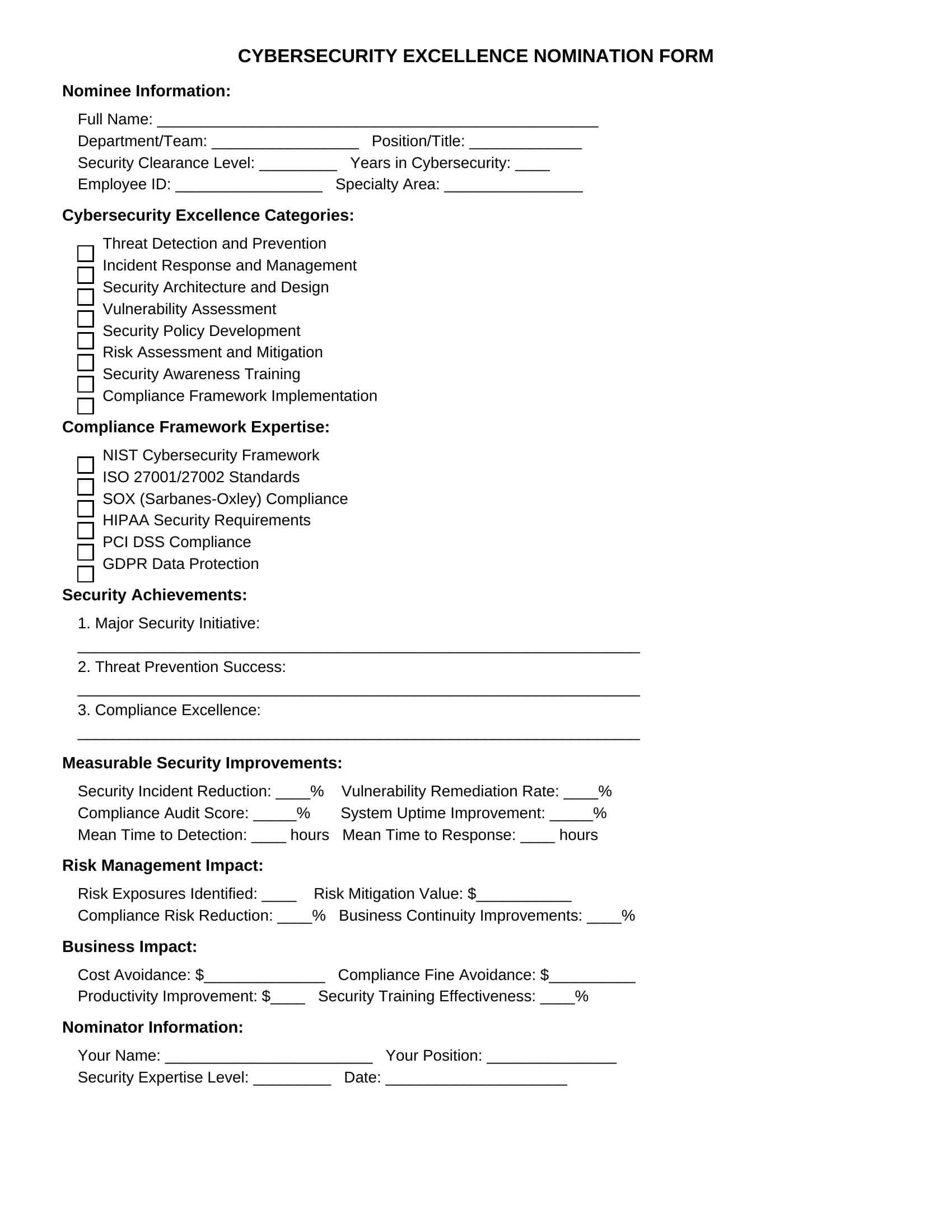
Link to: Employee_nomination_form_28.pdf
Corporate Form 3: Leadership and Strategic Thinking
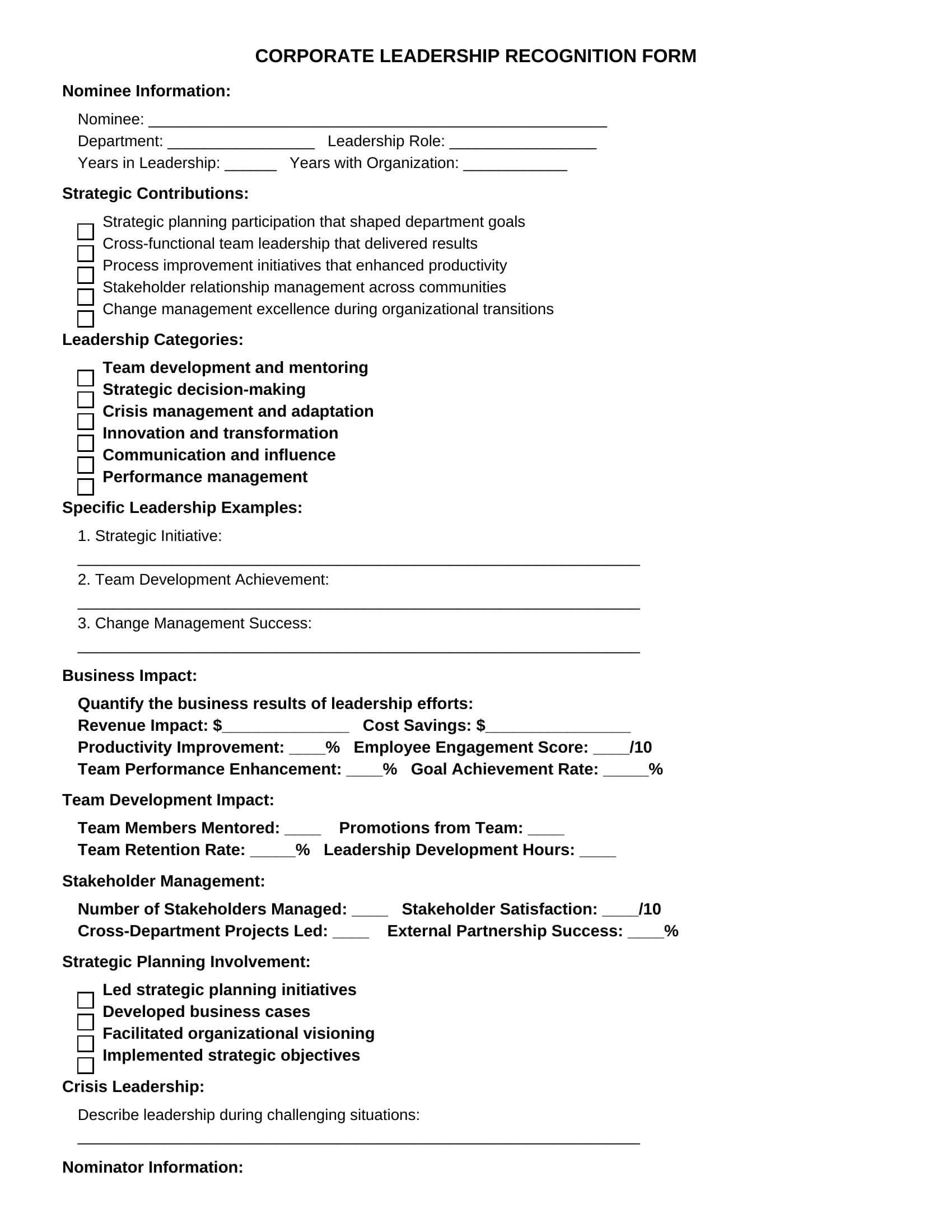
Link to: Employee_nomination_form_29.pdf
Corporate Form 4: Financial Performance and Analysis Tailored for finance professionals who excel in budget management, financial analysis, cost reduction, or revenue optimization initiatives that contribute to organizational success and meet financial goals.

Link to: Employee_nomination_form_30.pdf
Corporate Form 5: Project Management Excellence Recognizes project managers and coordinators who deliver successful outcomes, manage resources effectively, and facilitate team collaboration while meeting deadlines and budget requirements across departments.

Link to: Employee_nomination_form_31.pdf
5 education and non-profit employee recognition nomination form examples

Education Form 1: Teaching Excellence Template
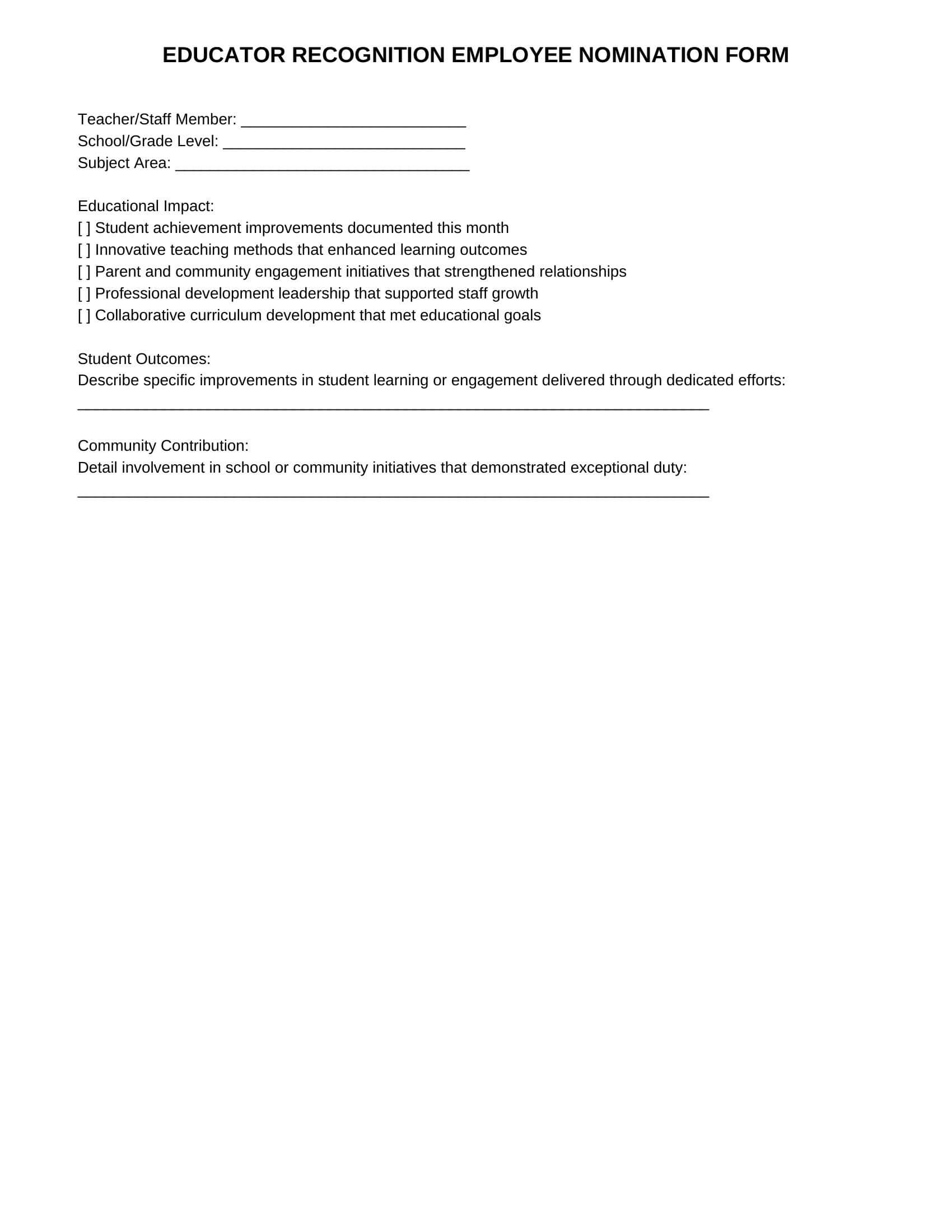
Link to: Employee_nomination_form_32.pdf
Education Form 2: Student Support Services Excellence Focuses on counselors, administrators, and support staff who create positive learning environments and support student success beyond the classroom while fostering strong school communities and family relationships. Educational institutions often incorporate sample write up for employee award nomination guidelines to help nominators craft compelling submissions.
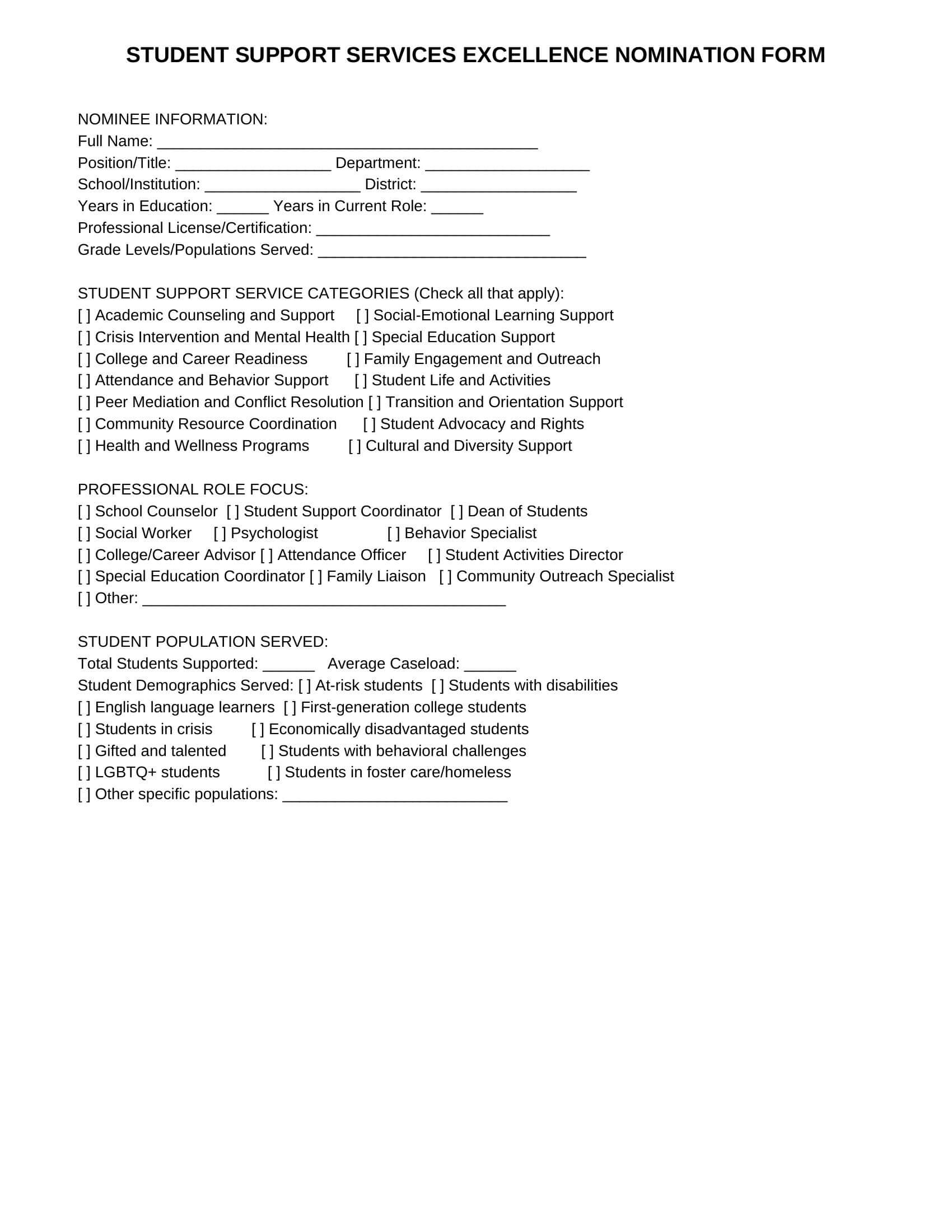
Link to: Employee_nomination_form_33.pdf
Non-Profit Form 3: Mission Impact Recognition
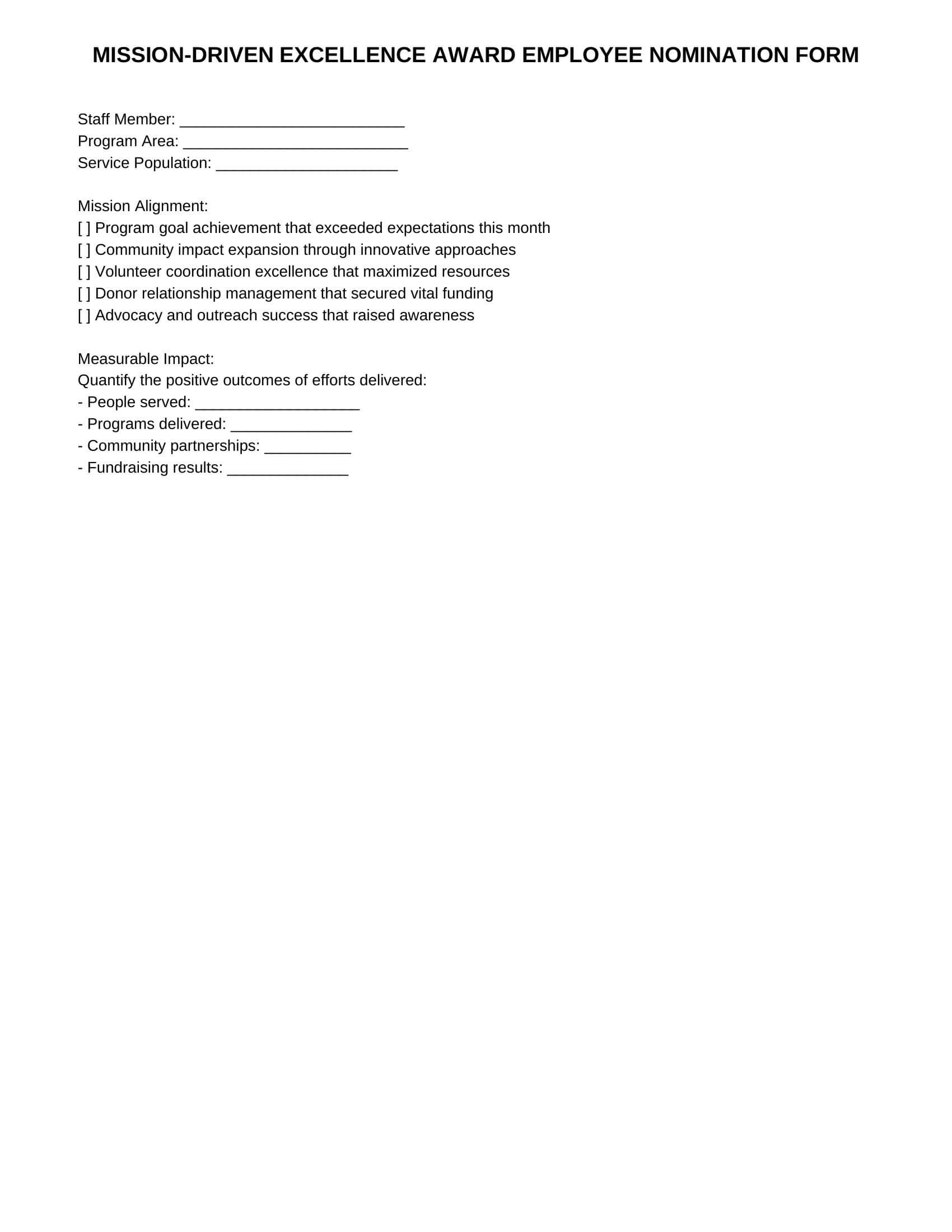
Link to: Employee_nomination_form_34.pdf
Non-Profit Form 4: Volunteer Coordination and Community Engagement Recognizes staff members who excel in volunteer management, community outreach, and stakeholder relationship building while creating strong partnerships that support organizational mission and goals.
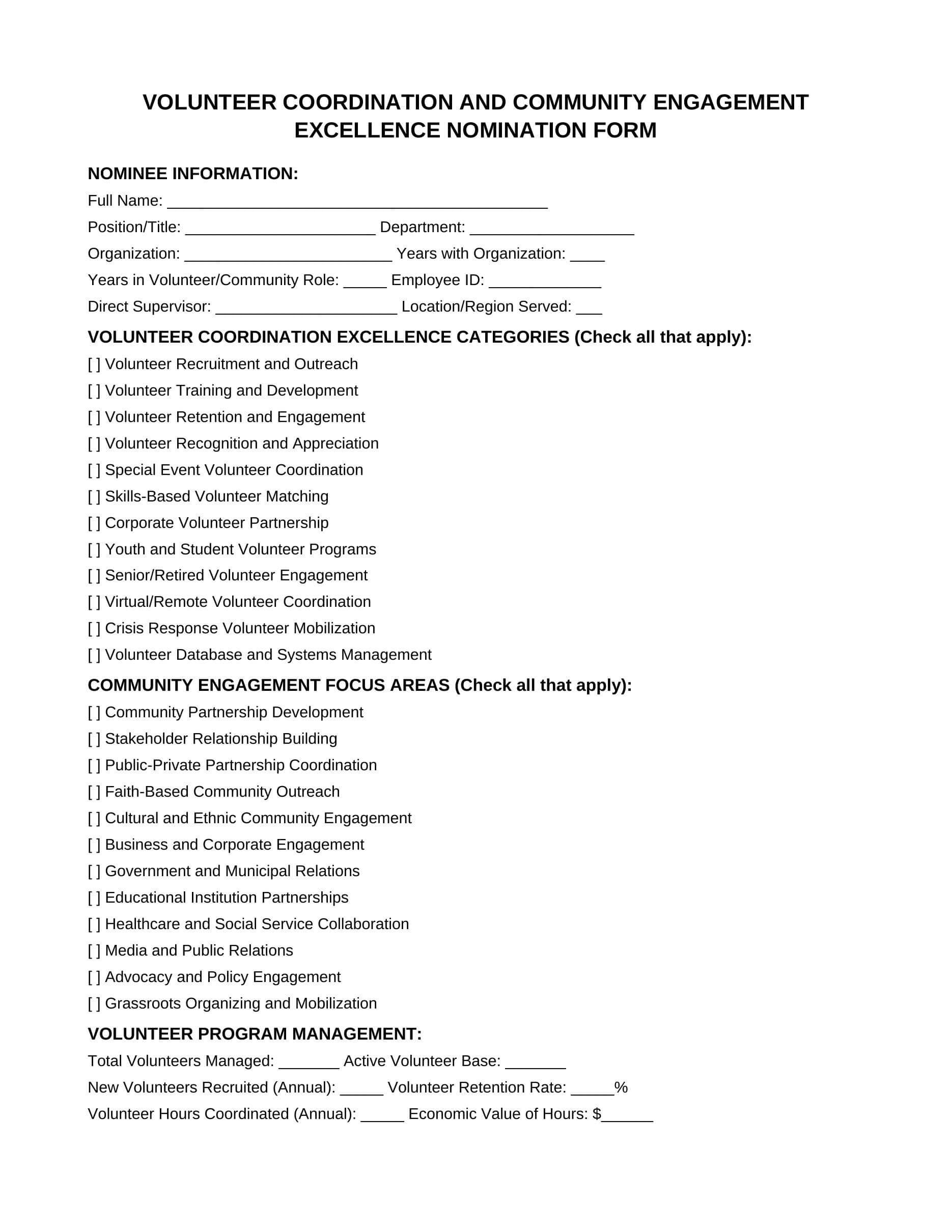
Link to: Employee_nomination_form_35.pdf
Non-Profit Form 5: Program Development and Innovation Celebrates employees who create new programs, improve service delivery, or develop innovative solutions to community challenges while demonstrating exceptional commitment to organizational purpose and community impact.
How to write a nomination letter and complete nomination forms effectively

Writing compelling nomination letters and completing employee nomination forms requires strategic thinking, specific examples, and clear communication that highlights the nominee's exceptional contributions across departments and teams. Effective nomination submissions go beyond basic job duties to demonstrate measurable impact, innovative thinking, and alignment with organizational values while providing concrete evidence of achievements. The key to successful nominations lies in providing detailed examples through structured content that tells a compelling story about the nominee's influence on teams, customers, or organizational goals each month.
Understanding how to structure nomination form submissions helps ensure that deserving employees receive appropriate recognition and consideration during the review and voting processes. The most effective approaches combine quantitative data with qualitative observations, creating comprehensive pictures of employee excellence that reviewers can easily evaluate and understand while maintaining fairness across all submissions and departments. Organizations benefit from providing employee nomination letter sample for coworker examples to guide nominators in crafting effective submissions.
Step-by-step process for completing employee nomination form submissions
The nomination process begins with thorough preparation and gathering relevant information about the nominee's achievements, impact, and qualifications for award consideration. Start by reviewing the specific criteria for the award or recognition program to ensure alignment between the nominee's contributions and the program's objectives while understanding how voting and decision making procedures work. Collect supporting evidence including performance metrics, customer feedback, project outcomes, and examples of behaviors that demonstrate company values or exceptional performance that meets organizational goals.
When completing the actual employee nomination form, follow these essential steps:
- Review all form sections before beginning to understand the complete scope of required information and questions
- Gather specific examples, data points, and testimonials that support the nomination with concrete evidence
- Draft responses in a separate document first to ensure thoughtful and complete answers that describe achievements effectively
- Use clear, concise language that quantifies achievements and describes measurable impact on productivity and team success
Begin with the nominee's basic information and role responsibilities within their department, then progress to specific achievements and their broader impact on organizational goals. Ensure that each section of the form receives adequate attention, providing detailed responses that give reviewers comprehensive understanding of why the nominee deserves recognition through the award process.
Essential writing techniques for compelling nomination form entries
Compelling nomination letters utilize specific storytelling techniques that bring achievements to life while maintaining professional tone and factual accuracy throughout the submission process. Start each major section with a strong opening statement that summarizes the nominee's most significant contribution, then provide supporting details and context that help reviewers understand the full scope of impact on teams and organizational productivity. Use active voice and specific verbs that convey action and results rather than passive descriptions of duties while maintaining accessibility for all readers.
Structure your writing to create a logical flow from individual achievements to broader organizational impact that demonstrates how the nominee's efforts support business goals and enhance team effectiveness. Include quantitative measures whenever possible, such as percentage improvements, cost savings, customer satisfaction scores, or productivity gains that provide concrete evidence of success. Balance numerical data with qualitative observations about leadership qualities, collaboration skills, or innovative thinking that demonstrate the nominee's full value to the organization and their dedicated service to communities.
Organizations often reference proven employee nomination sample formats to ensure consistent quality across submissions. Effective nomination letters also address potential questions or concerns that reviewers might have by providing context for achievements and explaining any unique circumstances that make the accomplishments particularly noteworthy each month. This comprehensive approach creates stronger nominations that stand out during the review and voting processes while ensuring fair consideration across all submissions.
Common mistakes that weaken employee of the month nomination form submissions
Many nomination submissions fail to achieve their intended impact due to common writing and structural mistakes that diminish the nominee's achievements and reduce their chances during voting procedures. Generic language and vague descriptions represent the most frequent issues, as these approaches fail to differentiate the nominee from other candidates or provide compelling reasons for recognition through award programs. Avoid phrases like "always does a great job" or "is a team player" without providing specific examples that demonstrate these qualities in action with measurable outcomes.
Another significant mistake involves focusing too heavily on job duties rather than exceptional performance that goes beyond standard expectations and demonstrates innovative approaches to meeting goals. Effective nominations distinguish between regular responsibilities and extraordinary contributions that warrant special recognition while highlighting efforts that enhance department productivity and team success. Additionally, many nominators fail to connect individual achievements to broader organizational goals or team success, missing opportunities to demonstrate strategic value through their submissions.
Technical errors also weaken nominations, including:
- Incomplete forms that leave sections blank or provide insufficient detail for proper review and evaluation
- Grammatical errors and poor formatting that create unprofessional impressions and reduce submission quality
- Missing deadlines or failing to follow submission guidelines outlined in program materials and website instructions
- Lack of supporting evidence or specific examples that substantiate claims about performance and achievements
To strengthen nominations, focus on measurable outcomes that demonstrate clear impact, provide specific timeframes for achievements that show consistent excellence, and ensure that all form sections receive thoughtful completion that helps reviewers understand the nominee's exceptional value to the organization and their dedicated efforts toward achieving shared goals.
15 advanced employee recognition nomination form strategies and customization

Advanced employee recognition nomination form strategies enable organizations to create sophisticated recognition systems that align with specific goals, integrate with existing processes, and provide meaningful data for organizational development across departments and teams. These approaches go beyond basic nomination collection to create comprehensive frameworks that support strategic HR objectives, improve employee engagement, and strengthen workplace culture while enhancing productivity and decision making capabilities. Successful customization requires understanding organizational needs, employee preferences, and the broader context in which recognition programs operate within diverse communities.
Modern organizations benefit from implementing multi-layered nomination systems that accommodate different recognition types, evaluation criteria, and stakeholder involvement levels through dedicated digital tools and survey platforms. These advanced strategies help ensure that nomination forms serve as powerful tools for talent development, performance management, and cultural reinforcement rather than simply administrative processes that collect basic information without strategic purpose or measurable impact. Organizations often leverage staff rewards concepts when developing comprehensive recognition strategies.
5 ways to customize employee of the month nomination form templates for your organization
Customization Strategy 1: Values-Based Criteria Integration Align nomination form questions and evaluation criteria with specific company values by creating dedicated sections that assess how nominees demonstrate core organizational principles through their daily efforts and exceptional contributions. This approach ensures that recognition reinforces desired behaviors while providing concrete examples of values in action that can be shared across departments and teams. Include specific questions about integrity, innovation, collaboration, or customer focus that reflect your organization's unique culture and priorities while supporting strategic goals and community engagement initiatives.
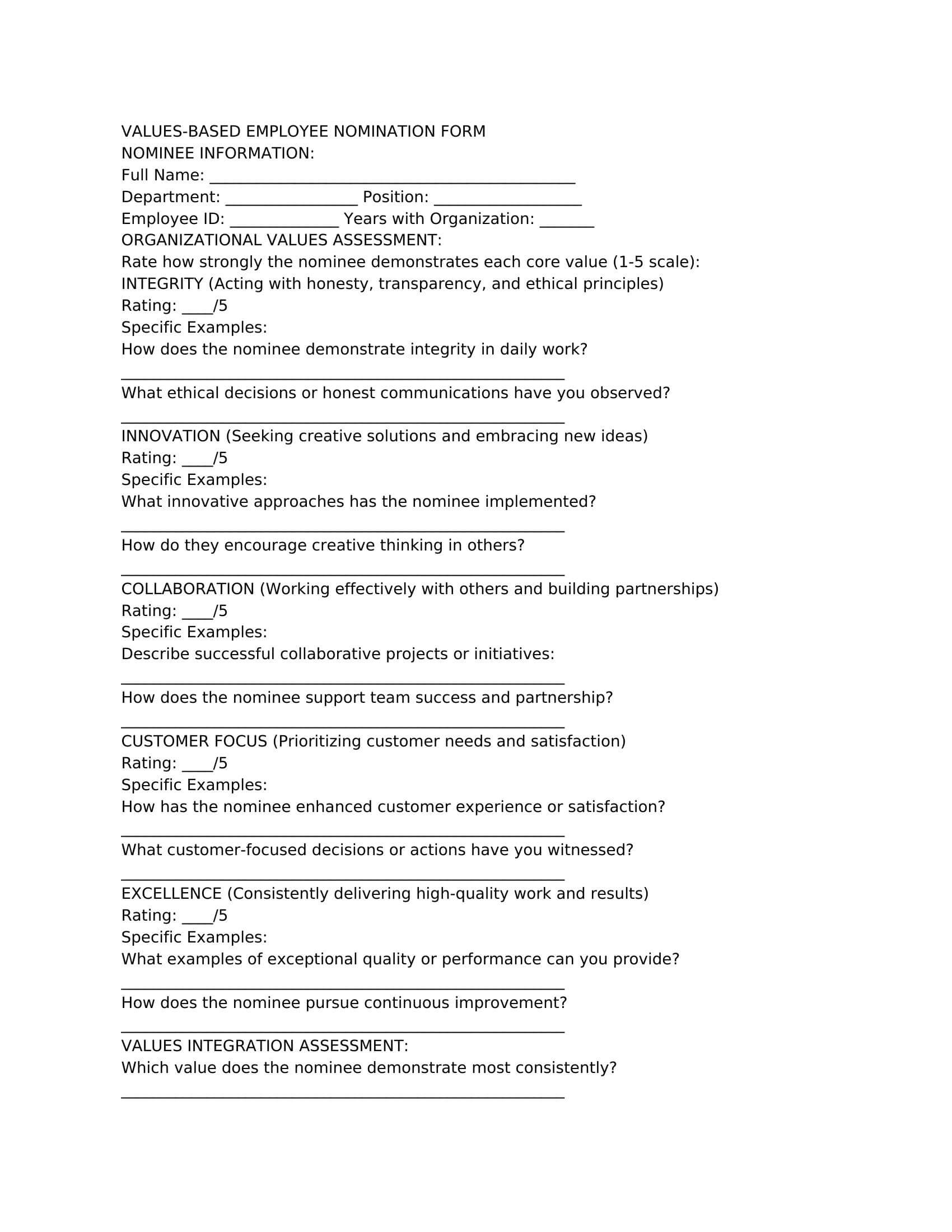
Link to: Employee_nomination_form_36.pdf
Customization Strategy 2: Role-Specific Performance Metrics Develop customized sections within nomination forms that address the unique responsibilities and success metrics for different positions or departments while maintaining fairness across all award categories. Sales teams might include revenue targets and customer acquisition metrics that demonstrate exceptional performance, while operations teams focus on efficiency improvements and process optimization that enhance organizational productivity. This targeted approach ensures that nominations capture relevant achievements that matter within specific organizational contexts and support diverse career paths.

Link to: Employee_nomination_form_37.pdf
Customization Strategy 3: Multi-Level Recognition Categories Create tiered nomination systems that accommodate different types of achievements, from daily excellence to transformational contributions that impact multiple departments or drive significant organizational change. Design form sections that differentiate between peer recognition, manager nominations, and leadership awards, ensuring that each category captures appropriate information for fair evaluation and transparent voting processes. This comprehensive approach enables organizations to recognize diverse types of excellence while maintaining consistent standards across all award programs.
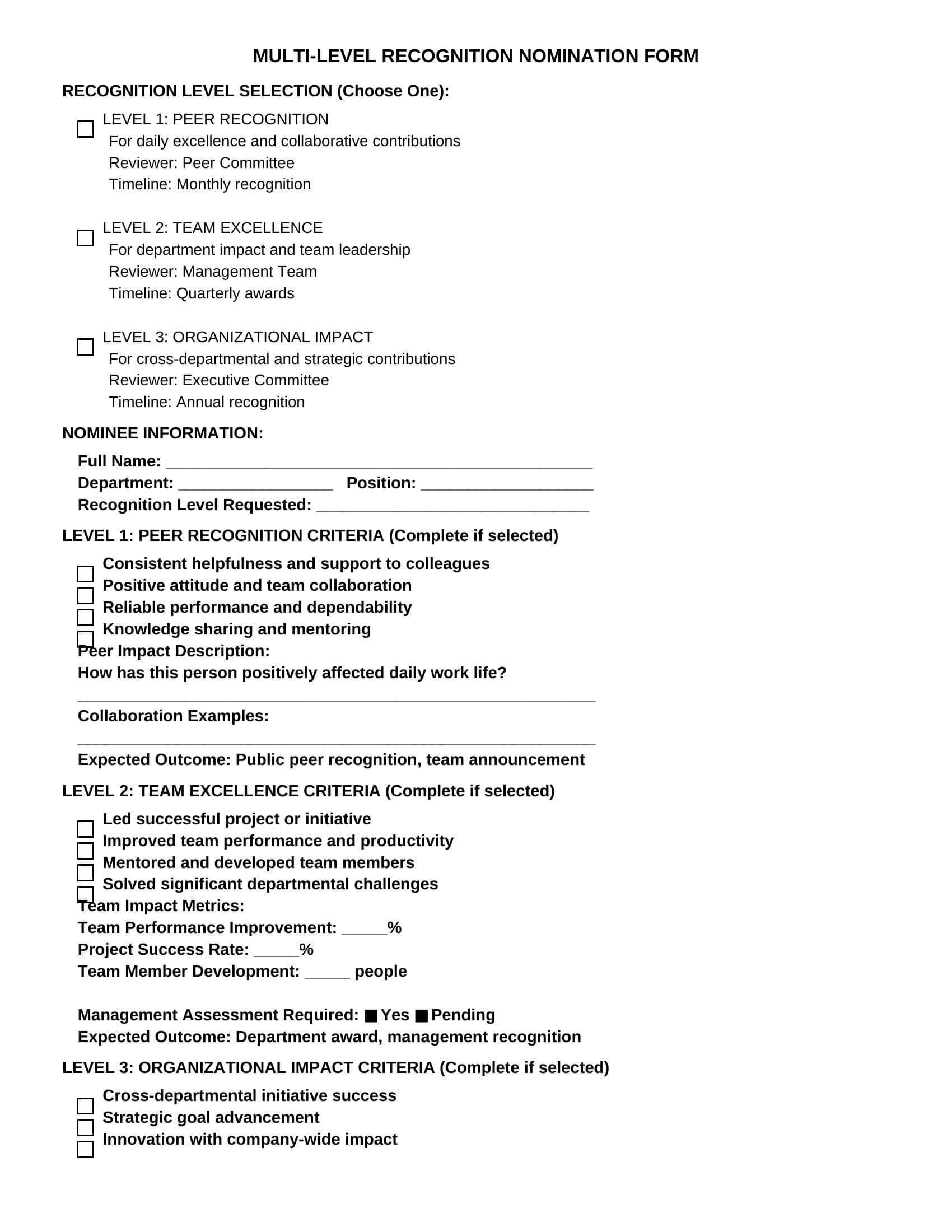
Link to: Employee_nomination_form_38.pdf
Customization Strategy 4: Cultural and Demographic Considerations Adapt nomination forms to reflect diverse workplace cultures, languages, and recognition preferences that exist within your organization and broader communities. Include options for anonymous submissions, culturally relevant achievement categories, and language translations that ensure all employees can participate meaningfully in recognition programs regardless of background or communication preferences.
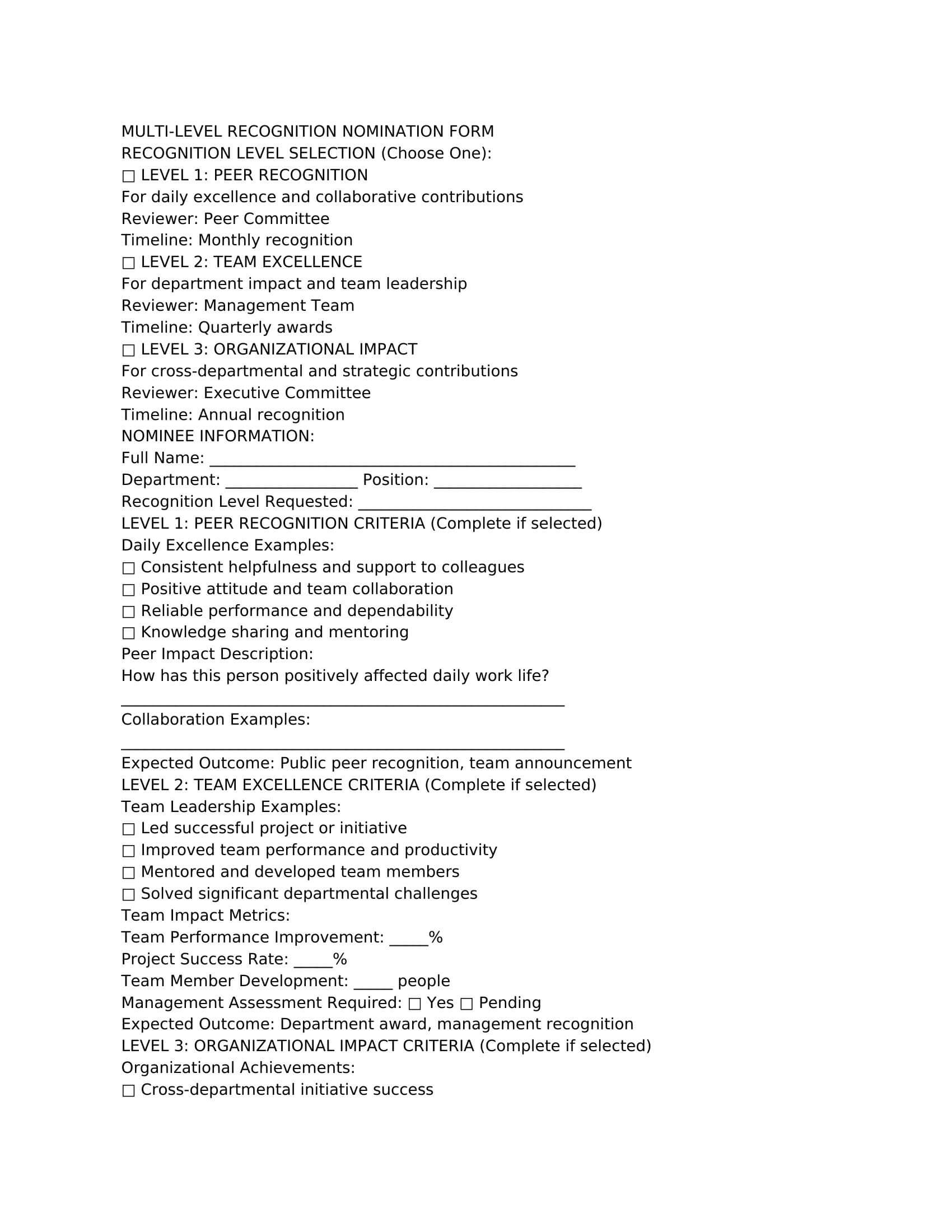
Link to: Employee_nomination_form_39.pdf
Customization Strategy 5: Integration with Development Goals Connect nomination forms with individual development plans and career progression pathways by including questions about skill demonstration, learning initiatives, and growth potential that support long-term employee success. This approach transforms recognition into a tool for talent development while providing valuable data for succession planning and performance management that benefits both individuals and organizational objectives.
5 integration methods for connecting nomination forms with evaluation processes

Integration Method 1: Performance Review Synchronization Connect employee nomination form data with annual performance reviews by creating shared databases that allow managers to reference recognition achievements during evaluation periods and decision making processes. This integration ensures that exceptional contributions captured through nominations become part of formal performance documentation and career development discussions while providing comprehensive views of employee excellence throughout each month and year. Organizations often incorporate team rewards concepts when connecting individual recognition with team performance metrics.
Integration Method 2: Real-Time Feedback Systems Implement nomination forms that trigger immediate feedback loops, sending notifications to managers, HR teams, and nominees when submissions occur through dedicated digital tools and automated workflows. This real-time approach enables timely recognition while providing opportunities for additional coaching, development, or recognition based on nominated achievements that demonstrate exceptional efforts and productivity improvements.
Integration Method 3: Analytics and Reporting Dashboard Create comprehensive reporting systems that analyze nomination data to identify trends, recognition gaps, and high-performing individuals or teams across departments and communities. These insights inform strategic decisions about recognition program effectiveness, training needs, and organizational development priorities while supporting data-driven decision making processes.
Integration benefits include:
- Data-driven insights that guide recognition program improvements and modifications based on actual submission patterns and voting trends
- Identification of recognition patterns that reveal organizational strengths and development areas across different departments and staff groups
- Automated reporting that reduces administrative burden while increasing program transparency and accessibility for all stakeholders
- Predictive analytics that help identify potential retention risks or promotion candidates based on recognition history and performance patterns
Integration Method 4: Workflow Automation Design nomination processes that automatically route submissions through appropriate approval chains, schedule review meetings, and generate follow-up communications through integrated digital tools and survey platforms. This systematic approach ensures consistent handling of nominations while reducing administrative workload for HR teams and managers across all departments and organizational levels.
Integration Method 5: Cross-Platform Connectivity Connect nomination forms with existing HR information systems, communication platforms, and recognition tools to create seamless user experiences and comprehensive data management capabilities. This integration eliminates duplicate data entry while ensuring that recognition information flows efficiently throughout organizational systems and supports strategic workforce planning initiatives.
5 best practices for printable employee of the month nomination form distribution
Distribution Practice 1: Multi-Channel Accessibility Ensure that printable employee of the month nomination forms reach all employees through diverse distribution channels including email attachments, intranet downloads, physical bulletin boards, and manager distribution systems. This comprehensive approach accommodates different communication preferences and workplace environments while maximizing participation opportunities across departments, teams, and communities regardless of technological access or preferences. Organizations benefit from incorporating employee rewards examples in distribution materials to inspire nominations.
Distribution Practice 2: Clear Timeline Communication Establish and communicate specific timelines for form distribution, completion, and submission that align with recognition program schedules and organizational calendars throughout each month. Provide multiple reminders and deadline notifications through various channels to ensure that interested nominators have adequate time to complete thoughtful submissions that demonstrate understanding of award criteria and nominee achievements.
Distribution Practice 3: Training and Support Resources Accompany form distribution with training materials, examples, and support resources that help employees understand how to complete effective nominations that capture meaningful contributions and measurable impact. Include sample completed forms, writing tips, and contact information for assistance to remove barriers that might prevent participation while ensuring submission quality across all departments and staff levels.
Distribution Practice 4: Feedback and Improvement Cycles Regularly collect feedback about form design, distribution methods, and completion processes to identify improvement opportunities and ensure that forms meet user needs while supporting organizational goals. This iterative approach enables continuous refinement of nomination systems based on actual user experiences and preferences while maintaining program effectiveness and accessibility for diverse communities.
Distribution Practice 5: Accessibility and Inclusion Focus Design distribution strategies that accommodate employees with different abilities, technology access levels, and language preferences to ensure equitable participation in recognition programs. Provide forms in multiple formats, languages, and accessibility options to ensure that all employees can participate equally in recognition programs regardless of individual circumstances or limitations while supporting organizational diversity and inclusion objectives.
How Matter can help with employee nomination forms
Matter transforms traditional employee nomination processes by providing a rich foundation of peer recognition data that naturally supports formal award submissions while integrating seamlessly with Slack and Teams to capture authentic appreciation throughout daily workflows. Rather than relying on static nomination forms alone, Matter creates comprehensive documentation of employee achievements through customizable kudos cards and milestone celebrations that strengthen employee rewards programs and provide compelling evidence for formal recognition submissions.
Organizations using Matter benefit from increased visibility into employee contributions, stronger nomination supporting documentation, and more meaningful recognition experiences that strengthen workplace culture. The platform's systematic approach to peer appreciation creates natural identification processes for exceptional contributors while maintaining detailed achievement histories that support comprehensive nomination efforts across departments and teams.
Building comprehensive recognition data that strengthens nomination submissions
Matter streamlines the nomination support process by capturing authentic peer recognition activities that provide valuable documentation for formal award submissions. The platform's customizable kudos cards allow colleagues to document specific achievements, values alignment, and exceptional contributions in real-time, creating rich portfolios of employee excellence that nominators can reference when completing formal submission materials.
The recognition tracking system enables organizations to identify potential nomination candidates through organic peer appreciation patterns while maintaining comprehensive records of achievement histories and collaborative contributions. Automated birthday and work anniversary celebrations provide additional recognition touchpoints that demonstrate employee participation in company culture. These celebrations generate visibility into team dynamics and long-term commitment that adds depth to formal award submissions.
Key features that support nomination documentation include:
- Values-based kudos cards that capture specific examples of how employees demonstrate company principles and organizational goals
- Achievement tracking through peer recognition that documents project successes, innovation, and collaborative contributions over time
- Cross-team visibility via Slack and Teams integration that highlights contributions across departments and functional areas
- Searchable recognition history that allows nominators to easily retrieve past appreciation and specific achievement examples
- Automated celebration features that maintain comprehensive records of employee engagement and milestone acknowledgment.
Capturing authentic peer feedback for stronger nomination cases
Matter's integration with Slack and Microsoft Teams captures real-time peer appreciation, providing authentic testimonials and specific examples of employee excellence. This creates valuable supporting evidence that strengthens formal nomination submissions. The platform's kudos cards include customizable messages that allow colleagues to provide detailed feedback about contributions, teamwork, and value demonstration, generating genuine peer endorsements that enhance nomination credibility.
Recognition data that enhances nomination quality encompasses detailed achievement documentation through kudos cards, which capture specific performance examples and the impact of contributions. Peer testimonials embedded in recognition messages offer authentic perspectives on the qualities of nominees, while frequency patterns demonstrate consistent excellence and reliability over extended periods. This systematic documentation provides compelling evidence that supports a diverse range of workplace rewards and recognition programs.
Benefits that strengthen nomination submissions include:
- Specific contribution examples documented through peer kudos that provide concrete evidence of exceptional performance and impact
- Authentic colleague testimonials, captured in recognition messages, offer genuine perspectives on the nominee's qualities and achievements.
- Consistent excellence is demonstrated through regular peer appreciation, which shows sustained high performance over time.
- Values alignment documentation that illustrates how nominees consistently embody organizational principles through daily actions
- Collaborative achievement records highlighted through cross-departmental recognition that demonstrates broader organizational impact
Seamless integration from daily recognition to formal nomination processes
Matter creates natural progression pathways from informal peer appreciation to formal nomination consideration through integrated workflows that transform daily recognition activities into systematic achievement documentation. The platform's straightforward setup process enables organizations to begin capturing valuable recognition data immediately, ensuring that exceptional contributions are documented as they occur rather than trying to reconstruct achievement histories during nomination periods.
The platform's coin-based reward system encourages regular participation in recognition activities, ensuring that outstanding contributors receive ongoing acknowledgment that can translate into formal award opportunities. Weekly coin distribution resets regularly to maintain authentic appreciation while preventing gaming behaviors, supporting genuine recognition patterns that reflect actual employee excellence and contribution impact.
Integration advantages that support nomination processes include:
- Real-time achievement capture through kudos cards that document specific contributions as they happen, creating detailed achievement timelines.
- Consistent documentation via Feedback Friday automation that maintains ongoing appreciation activity throughout the year
- Multi-channel recognition visibility that highlights diverse contributions across departments, projects, and collaborative initiatives
- Comprehensive milestone tracking through automated celebrations that provide context about employee tenure and relationship building
- Accessible recognition history within Slack and Teams that enables easy retrieval of supporting documentation during nomination preparation
Matter's focus on authentic peer appreciation ensures that formal nomination processes are supported by genuine colleague feedback and detailed documentation of achievements. The platform's free forever plan allows organizations to begin building recognition foundations immediately, with scalable options that support growing nomination programs while driving employee engagement through consistent appreciation and meaningful recognition experiences.
FAQs about employee nomination forms
Q: Where can I find the best employee nomination form templates for my organization?
A: The best employee nomination form templates are available through HR platforms like Matter, which provides customizable templates that integrate with workplace digital tools and surveys. You can also create custom forms using survey platforms, download templates from HR resource websites, or adapt industry-specific examples to meet your organization's unique needs and recognition objectives while ensuring accessibility for all staff and departments.
Q: How do I create an effective employee of the month nomination form template?
A: Create effective employee of the month nomination form templates by including clear award criteria, specific achievement categories, and space for detailed examples that demonstrate measurable impact and exceptional efforts. Include sections for nominee information, accomplishment descriptions, measurable outcomes, and nominator details while ensuring questions align with company values and provide guidance that helps nominators submit meaningful submissions efficiently.
Q: What should I include in my employee recognition nomination form examples?
A: Include nominee identification fields, specific achievement descriptions, impact measurements, alignment with company values, and supporting evidence in your employee recognition nomination form examples. Add sections for nominator information, submission dates, and any required approvals while ensuring forms capture both quantitative results and qualitative observations about exceptional performance that meets organizational goals and demonstrates dedicated efforts.
Q: Can I customize printable employee of the month nomination form templates?
A: Yes, printable employee of the month nomination form templates can be customized to reflect your organization's specific needs, values, and award categories while maintaining accessibility for all users. Modify questions to address role-specific achievements, add company branding elements, adjust formatting for your preferred distribution methods, and include any additional fields that support your recognition program objectives and voting procedures.
Q: How do I write a nomination letter using standard nomination forms?
A: Write effective nomination letters using standard forms by providing specific examples, quantifying achievements, and connecting individual contributions to broader organizational goals while demonstrating understanding of award criteria. Use clear, professional language that describes measurable impact while highlighting behaviors that demonstrate company values and exceptional efforts that benefit teams, departments, and communities.
Q: What makes nomination form for employee of the month more effective than generic forms?
A: Nomination forms for employee of the month are more effective than generic forms because they include specific criteria relevant to monthly recognition cycles, focus on recent achievements, and provide structured evaluation processes that support fair decision making. These specialized forms capture time-specific accomplishments while ensuring consistent information collection that supports transparent comparison between nominees and equitable selection processes across departments and staff groups.
Final thoughts about employee nomination forms
Employee nomination forms represent powerful tools for building recognition-rich workplace cultures that celebrate excellence and strengthen team relationships across departments and communities. Organizations that implement well-designed nomination systems create structured pathways for acknowledging outstanding contributions while ensuring fair and transparent recognition processes that support employee engagement and productivity. The key to success lies in developing forms that balance comprehensive information collection with user-friendly design that encourages widespread participation from employees across all departments and levels throughout each month.
Effective nomination forms serve multiple organizational objectives by capturing valuable performance data, reinforcing company values, and creating opportunities for meaningful employee engagement through structured award processes and voting procedures. When employees understand that their efforts can be recognized through accessible nomination processes delivered via digital tools and surveys, it builds trust in organizational commitment to appreciation and creates positive feedback loops that enhance workplace culture. The investment in quality nomination systems pays dividends through improved retention, increased productivity, and stronger team cohesion across all staff groups and communities.
The future of employee recognition increasingly relies on integrated systems that connect nomination processes with broader talent management strategies and organizational development goals while supporting strategic decision making. Organizations that prioritize comprehensive nomination systems create environments where recognition becomes embedded in daily operations, leading to sustainable improvements in employee satisfaction and organizational performance. The most successful companies recognize that nomination forms are not merely administrative tools but strategic investments in employee engagement and organizational success that benefit all stakeholders throughout the recognition process.
Ready to take your employee incentive strategy to the next level? Schedule a demo with a Matter expert today and discover how the right tools can help you recognize great work, boost engagement, and support long-term business success.
























